Antibody data
- Antibody Data
- Antigen structure
- References [200]
- Comments [0]
- Validations
- Immunohistochemistry [3]
- Other assay [30]
Submit
Validation data
Reference
Comment
Report error
- Product number
- 51-9000 - Provider product page

- Provider
- Invitrogen Antibodies
- Product name
- Claudin 1 Polyclonal Antibody
- Antibody type
- Polyclonal
- Antigen
- Synthetic peptide
- Reactivity
- Human, Rat, Chicken/Avian
- Host
- Rabbit
- Isotype
- IgG
- Vial size
- 100 μg
- Concentration
- 0.25 mg/mL
- Storage
- -20°C
Submitted references Cellular Distribution Pattern of tjp1 (ZO-1) in Xenopus laevis Oocytes Heterologously Expressing Claudins.
Supply Chain Disruptions During COVID-19 Pandemic Uncover Differences in Keratinocyte Culture Media.
MarvelD3 Is Upregulated in Ulcerative Colitis and Has Attenuating Effects during Colitis Indirectly Stabilizing the Intestinal Barrier.
Impairment of the Retinal Endothelial Cell Barrier Induced by Long-Term Treatment with VEGF-A(165) No Longer Depends on the Growth Factor's Presence.
Heat stress-induced mucosal barrier dysfunction is potentially associated with gut microbiota dysbiosis in pigs.
Spermine protects intestinal barrier integrity through ras-related C3 botulinum toxin substrate 1/phospholipase C-γ1 signaling pathway in piglets.
Glycine represses endoplasmic reticulum stress-related apoptosis and improves intestinal barrier by activating mammalian target of rapamycin complex 1 signaling.
Beovu, but not Lucentis impairs the function of the barrier formed by retinal endothelial cells in vitro.
Mucin O-glycan-microbiota axis orchestrates gut homeostasis in a diarrheal pig model.
Nicotinamide mononucleotide ameliorates adriamycin-induced renal damage by epigenetically suppressing the NMN/NAD consumers mediated by Twist2.
Protective Effect of the Abelmoschus manihot Flower Extract on DSS-Induced Ulcerative Colitis in Mice.
Altered Mucus Barrier Integrity and Increased Susceptibility to Colitis in Mice upon Loss of Telocyte Bone Morphogenetic Protein Signalling.
Erythromycin reduces nasal inflammation by inhibiting immunoglobulin production, attenuating mucus secretion, and modulating cytokine expression.
Expression of E-Cadherin in Epithelial Cancer Cells Increases Cell Motility and Directionality through the Localization of ZO-1 during Collective Cell Migration.
Butyrate Alleviates Cytokine-Induced Barrier Dysfunction by Modifying Claudin-2 Levels.
The psychoactive drug of abuse mephedrone differentially disrupts blood-brain barrier properties.
Pre-emptive Short-term Nicotinamide Mononucleotide Treatment in a Mouse Model of Diabetic Nephropathy.
Fat1 deletion promotes hybrid EMT state, tumour stemness and metastasis.
Tight junctions in the blood-brain barrier promote edema formation and infarct size in stroke - Ambivalent effects of sealing proteins.
Quercetin Alleviates Oxidative Damage by Activating Nuclear Factor Erythroid 2-Related Factor 2 Signaling in Porcine Enterocytes.
Necroptosis is active and contributes to intestinal injury in a piglet model with lipopolysaccharide challenge.
Desmosomes polarize and integrate chemical and mechanical signaling to govern epidermal tissue form and function.
Tumor Necrosis Factor Alpha Effects on the Porcine Intestinal Epithelial Barrier Include Enhanced Expression of TNF Receptor 1.
Sitagliptin and the Blood-Retina Barrier: Effects on Retinal Endothelial Cells Manifested Only after Prolonged Exposure.
E7 oncoprotein from human papillomavirus 16 alters claudins expression and the sealing of epithelial tight junctions.
Retinal capillary degeneration and blood-retinal barrier disruption in murine models of Alzheimer's disease.
Biphasic MIF and SDF1 expression during podocyte injury promote CD44-mediated glomerular parietal cell migration in focal segmental glomerulosclerosis.
Claudin expression profile in flat wart and cutaneous squamous cell carcinoma in epidermodysplasia verruciformis.
Interaction of alcohol with time of eating on markers of circadian dyssynchrony and colon tissue injury.
The JAK-Inhibitor Tofacitinib Rescues Human Intestinal Epithelial Cells and Colonoids from Cytokine-Induced Barrier Dysfunction.
Inflammation of the Embryonic Choroid Plexus Barrier following Maternal Immune Activation.
Mechanisms of stretch-mediated skin expansion at single-cell resolution.
FDPS promotes glioma growth and macrophage recruitment by regulating CCL20 via Wnt/β-catenin signalling pathway.
Human Immunodeficiency Virus-Associated Exosomes Promote Kaposi's Sarcoma-Associated Herpesvirus Infection via the Epidermal Growth Factor Receptor.
Syncytiotrophoblast of Placentae from Women with Zika Virus Infection Has Altered Tight Junction Protein Expression and Increased Paracellular Permeability.
Effects of Claudin-1 on the Action of Clostridium perfringens Enterotoxin in Caco-2 Cells.
Claudins and JAM-A coordinately regulate tight junction formation and epithelial polarity.
Toll-like receptor 5-mediated IL-17C expression in intestinal epithelial cells enhances epithelial host defense against F4(+) ETEC infection.
Effect of Manitoba-Grown Red-Osier Dogwood Extracts on Recovering Caco-2 Cells from H(2)O(2)-Induced Oxidative Damage.
Epithelial HIF-1α/claudin-1 axis regulates barrier dysfunction in eosinophilic esophagitis.
Enhanced gastrointestinal passive paracellular permeability contributes to the obesity-associated hyperoxaluria.
Pharmacological stimulation of G-protein coupled receptor 40 alleviates cytokine-induced epithelial barrier disruption in airway epithelial Calu-3 cells.
Quantitative and Microstructural Changes of the Blood-Nerve Barrier in Peripheral Neuropathy.
High MUC2 Mucin Biosynthesis in Goblet Cells Impedes Restitution and Wound Healing by Elevating Endoplasmic Reticulum Stress and Altered Production of Growth Factors.
Medium-Chain Triglycerides Attenuate Liver Injury in Lipopolysaccharide-Challenged Pigs by Inhibiting Necroptotic and Inflammatory Signaling Pathways.
Medium-chain TAG improve intestinal integrity by suppressing toll-like receptor 4, nucleotide-binding oligomerisation domain proteins and necroptosis signalling in weanling piglets challenged with lipopolysaccharide.
Claudin-3 Loss Causes Leakage of Sweat from the Sweat Gland to Contribute to the Pathogenesis of Atopic Dermatitis.
Knockout of ClC-2 reveals critical functions of adherens junctions in colonic homeostasis and tumorigenicity.
Counteracting the effects of TNF receptor-1 has therapeutic potential in Alzheimer's disease.
Entamoeba histolytica EhCP112 Dislocates and Degrades Claudin-1 and Claudin-2 at Tight Junctions of the Intestinal Epithelium.
Altered Cytokine Expression and Barrier Properties after In Vitro Infection of Porcine Epithelial Cells with Enterotoxigenic Escherichia coli and Probiotic Enterococcus faecium.
Claudin-4 knockout by TALEN-mediated gene targeting in MDCK cells: Claudin-4 is dispensable for the permeability properties of tight junctions in wild-type MDCK cells.
HCV replication in gastrointestinal mucosa: Potential extra-hepatic viral reservoir and possible role in HCV infection recurrence after liver transplantation.
The role of human fibronectin- or placenta basement membrane extract-based gels in favouring the formation of polarized salivary acinar-like structures.
Blood-spinal cord barrier breakdown and pericyte deficiency in peripheral neuropathy.
Asparagine preserves intestinal barrier function from LPS-induced injury and regulates CRF/CRFR signaling pathway.
Impaired Tight Junctions in Atopic Dermatitis Skin and in a Skin-Equivalent Model Treated with Interleukin-17.
The serine protease-mediated increase in intestinal epithelial barrier function is dependent on occludin and requires an intact tight junction.
Identification of a novel mechanism of blood-brain communication during peripheral inflammation via choroid plexus-derived extracellular vesicles.
TLR4-Dependent Claudin-1 Internalization and Secretagogue-Mediated Chloride Secretion Regulate Irinotecan-Induced Diarrhea.
Analgesic drug delivery via recombinant tissue plasminogen activator and microRNA-183-triggered opening of the blood-nerve barrier.
Fish oil enhances intestinal barrier function and inhibits corticotropin-releasing hormone/corticotropin-releasing hormone receptor 1 signalling pathway in weaned pigs after lipopolysaccharide challenge.
SPROUTY-2 represses the epithelial phenotype of colon carcinoma cells via upregulation of ZEB1 mediated by ETS1 and miR-200/miR-150.
Immunohistological study of tight junction protein expression in mal de Meleda.
The barrier function of organotypic non-melanoma skin cancer models.
Modeling immune functions of the mouse blood-cerebrospinal fluid barrier in vitro: primary rather than immortalized mouse choroid plexus epithelial cells are suited to study immune cell migration across this brain barrier.
Subcellular proteomics analysis of different stages of colorectal cancer cell lines.
Metformin prevents the effects of Pseudomonas aeruginosa on airway epithelial tight junctions and restricts hyperglycaemia-induced bacterial growth.
Rapamycin, a specific inhibitor of the target of rapamycin complex 1, disrupts intestinal barrier integrity in broiler chicks.
Changes in the cerebrospinal fluid circulatory system of the developing rat: quantitative volumetric analysis and effect on blood-CSF permeability interpretation.
Claudin-2 knockout by TALEN-mediated gene targeting in MDCK cells: claudin-2 independently determines the leaky property of tight junctions in MDCK cells.
Heterogeneity between triple negative breast cancer cells due to differential activation of Wnt and PI3K/AKT pathways.
Alterations of intercellular junctions in peritoneal mesothelial cells from patients undergoing dialysis: effect of retinoic Acid.
Mode of action of claudin peptidomimetics in the transient opening of cellular tight junction barriers.
A non-tight junction function of claudin-7-Interaction with integrin signaling in suppressing lung cancer cell proliferation and detachment.
Homoharringtonine increases intestinal epithelial permeability by modulating specific claudin isoforms in Caco-2 cell monolayers.
Expression of tight-junction proteins in human proximal small intestinal mucosa before and after Roux-en-Y gastric bypass surgery.
Enteral delivery of proteins enhances the expression of proteins involved in the cytoskeleton and protein biosynthesis in human duodenal mucosa.
Breaking immune tolerance by targeting Foxp3(+) regulatory T cells mitigates Alzheimer's disease pathology.
Neuroinvasion of the highly pathogenic influenza virus H7N1 is caused by disruption of the blood brain barrier in an avian model.
Loss of EP2 receptor subtype in colonic cells compromise epithelial barrier integrity by altering claudin-4.
Effect of wild-type Shigella species and attenuated Shigella vaccine candidates on small intestinal barrier function, antigen trafficking, and cytokine release.
Peanut allergens alter intestinal barrier permeability and tight junction localisation in Caco-2 cell cultures.
Claudin-1 is a novel target of miR-375 in non-small-cell lung cancer.
Autonomous isolation, long-term culture and differentiation potential of adult salivary gland-derived stem/progenitor cells.
Effects of in utero exposure of C57BL/6J mice to 2,3,7,8-tetrachlorodibenzo-p-dioxin on epidermal permeability barrier development and function.
Nrf2 deficiency impairs the barrier function of mouse oesophageal epithelium.
Tight junctional localization of claudin-16 is regulated by syntaxin 8 in renal tubular epithelial cells.
p38δ mitogen-activated protein kinase regulates the expression of tight junction protein ZO-1 in differentiating human epidermal keratinocytes.
Diets high in fermentable protein and fibre alter tight junction protein composition with minor effects on barrier function in piglet colon.
Alternative endocytosis pathway for productive entry of hepatitis C virus.
Claudin-3 overexpression increases the malignant potential of colorectal cancer cells: roles of ERK1/2 and PI3K-Akt as modulators of EGFR signaling.
Production, purification and characterization of recombinant, full-length human claudin-1.
Transmigration of neural stem cells across the blood brain barrier induced by glioma cells.
Scribble regulates an EMT polarity pathway through modulation of MAPK-ERK signaling to mediate junction formation.
Tanycyte-like cells form a blood-cerebrospinal fluid barrier in the circumventricular organs of the mouse brain.
Papillomavirus E6 oncoprotein up-regulates occludin and ZO-2 expression in ovariectomized mice epidermis.
Build them up and break them down: Tight junctions of cell lines expressing typical hepatocyte polarity with a varied repertoire of claudins.
Physiology of blood-brain interfaces in relation to brain disposition of small compounds and macromolecules.
Helicobacter pylori-induced disruption of monolayer permeability and proinflammatory cytokine secretion in polarized human gastric epithelial cells.
Rab25 regulates integrin expression in polarized colonic epithelial cells.
Matrix metalloproteinase 13 modulates intestinal epithelial barrier integrity in inflammatory diseases by activating TNF.
Ameliorative effect of PACAP and VIP against increased permeability in a model of outer blood retinal barrier dysfunction.
miR-199a-5p regulates urothelial permeability and may play a role in bladder pain syndrome.
Cell-cell contact-mediated hepatitis C virus (HCV) transfer, productive infection, and replication and their requirement for HCV receptors.
Functional tight junction barrier localizes in the second layer of the stratum granulosum of human epidermis.
Role of tight junction proteins in gastroesophageal reflux disease.
CDH1 is essential for endometrial differentiation, gland development, and adult function in the mouse uterus.
Dynamic distribution of claudin proteins in pancreatic epithelia undergoing morphogenesis or neoplastic transformation.
Prostaglandin-induced cervical remodelling in humans in the first trimester is associated with increased expression of specific tight junction, but not gap junction proteins.
Phosphorylation of Rab11-FIP2 regulates polarity in MDCK cells.
Effects of proinflammatory cytokines on the claudin-19 rich tight junctions of human retinal pigment epithelium.
Modeling hepatitis C virus infection using human induced pluripotent stem cells.
Complexity and developmental changes in the expression pattern of claudins at the blood-CSF barrier.
Identification of claudins by western blot and immunofluorescence in different cell lines and tissues.
Functional ESCRT machinery is required for constitutive recycling of claudin-1 and maintenance of polarity in vertebrate epithelial cells.
Relocalization of cell adhesion molecules during neoplastic transformation of human fibroblasts.
Claudin-1 induced sealing of blood-brain barrier tight junctions ameliorates chronic experimental autoimmune encephalomyelitis.
Cyclooxygenase-2 deficiency leads to intestinal barrier dysfunction and increased mortality during polymicrobial sepsis.
Matrigel improves functional properties of primary human salivary gland cells.
Ouabain modulates ciliogenesis in epithelial cells.
Loss of Smad5 leads to the disassembly of the apical junctional complex and increased susceptibility to experimental colitis.
Ovarian hormones control the changing expression of claudins and occludin in rat uterine epithelial cells during early pregnancy.
Immunocytochemical localization of claudin-1 in the maturation ameloblasts of rat incisors.
CRTAM: A molecule involved in epithelial cell adhesion.
Differential expression of claudin tight junction proteins in the human cortical nephron.
Maternal glucocorticoid exposure alters tight junction protein expression in the brain of fetal sheep.
Persistent hepatitis C virus infection in microscale primary human hepatocyte cultures.
Adenovirus-driven overexpression of proteinases in organ-cultured normal human corneas leads to diabetic-like changes.
Normalization of wound healing and diabetic markers in organ cultured human diabetic corneas by adenoviral delivery of c-Met gene.
Impairment of intestinal barrier and secretory function as well as egg excretion during intestinal schistosomiasis occur independently of mouse mast cell protease-1.
Tight junctions in Hailey-Hailey and Darier's diseases.
Tight junction proteins in human Schwann cell autotypic junctions.
Expression of tight-junction proteins in the inflamed and clinically uninvolved skin in patients with venous leg ulcers.
Phosphorylation of claudin-4 is required for tight junction formation in a human keratinocyte cell line.
Blood-testis barrier dynamics are regulated by testosterone and cytokines via their differential effects on the kinetics of protein endocytosis and recycling in Sertoli cells.
Expression and localisation of apical junctional complex proteins in lens epithelial cells.
Distribution of tight junction proteins in adult human salivary glands.
Distinct molecular composition of blood and lymphatic vascular endothelial cell junctions establishes specific functional barriers within the peripheral lymph node.
Heat-induced antigen retrieval: mechanisms and application to histochemistry.
Structural alterations of epididymal epithelial cells in cathepsin A-deficient mice affect the blood-epididymal barrier and lead to altered sperm motility.
Tight junction components occludin, ZO-1, and claudin-1, -4 and -5 in active and healing psoriasis.
Differentiation potential of urothelium from patients with benign bladder dysfunction.
Differences in claudin synthesis in primary cultures of acinar cells from rat salivary gland are correlated with the specific three-dimensional organization of the cells.
Immunolocalization of tight junction proteins in blood vessels in human germinal matrix and cortex.
Tight and adherens junctions in the ovine uterus: differential regulation by pregnancy and progesterone.
Novel fibroblastic onion bulbs in a demyelinating avian peripheral neuropathy produced by riboflavin deficiency.
Claudin 1 differentiates endometrioid and serous papillary endometrial adenocarcinoma.
Prostate cancer progression into androgen independency is associated with alterations in cell adhesion and invasivity.
Endothelia of term human placentae display diminished expression of tight junction proteins during preeclampsia.
Amyloid beta-peptide1-42 alters tight junction protein distribution and expression in brain microvessel endothelial cells.
Tight junction proteins and perineurial cells in neurofibromas.
CCL2/monocyte chemoattractant protein-1 mediates enhanced transmigration of human immunodeficiency virus (HIV)-infected leukocytes across the blood-brain barrier: a potential mechanism of HIV-CNS invasion and NeuroAIDS.
Roles of ZO-1, occludin, and actin in oxidant-induced barrier disruption.
Cell junctional proteins in the human corpus luteum: changes during the normal cycle and after HCG treatment.
Changes of cell adhesion and extracellular matrix (ECM) components in cervical intraepithelial neoplasia.
The Rac activator Tiam1 controls tight junction biogenesis in keratinocytes through binding to and activation of the Par polarity complex.
Inducible expression of Snail selectively increases paracellular ion permeability and differentially modulates tight junction proteins.
Drebrin, an actin-binding, cell-type characteristic protein: induction and localization in epithelial skin tumors and cultured keratinocytes.
Knockdown of occludin expression leads to diverse phenotypic alterations in epithelial cells.
Amphiregulin causes functional downregulation of adherens junctions in psoriasis.
Functional organization of the bovine rumen epithelium.
Changes in the distribution of ZO-1, occludin, and claudins in the rat uterine epithelium during the estrous cycle.
Extracellular signal-regulated kinases 1/2 control claudin-2 expression in Madin-Darby canine kidney strain I and II cells.
Chronic inflammatory pain leads to increased blood-brain barrier permeability and tight junction protein alterations.
Cultured monolayers of the dog jejunum with the structural and functional properties resembling the normal epithelium.
Paracellular Cl- permeability is regulated by WNK4 kinase: insight into normal physiology and hypertension.
Isoforms of the polarity protein par6 have distinct functions.
Ochratoxin A increases permeability through tight junctions by removal of specific claudin isoforms.
Endocytosis of epithelial apical junctional proteins by a clathrin-mediated pathway into a unique storage compartment.
Epidermal growth factor receptor activation differentially regulates claudin expression and enhances transepithelial resistance in Madin-Darby canine kidney cells.
Astrocyte mediated modulation of blood-brain barrier permeability does not correlate with a loss of tight junction proteins from the cellular contacts.
Mechanisms of diarrhea in the interleukin-2-deficient mouse model of colonic inflammation.
Mechanism of recruiting Sec6/8 (exocyst) complex to the apical junctional complex during polarization of epithelial cells.
Aeromonas hydrophila beta-hemolysin induces active chloride secretion in colon epithelial cells (HT-29/B6).
Tight junction proteins ZO-1, occludin, and claudins in developing and adult human perineurium.
Tight junction-associated proteins (occludin, ZO-1, claudin-1, claudin-4) in squamous cell carcinoma and Bowen's disease.
The specific fates of tight junction proteins in apoptotic epithelial cells.
Interferon-gamma down-regulates claudin-1 and impairs the epithelial barrier function in primary cultured human thyrocytes.
Interferon-gamma down-regulates claudin-1 and impairs the epithelial barrier function in primary cultured human thyrocytes.
Role of claudin interactions in airway tight junctional permeability.
Claudin extracellular domains determine paracellular charge selectivity and resistance but not tight junction fibril architecture.
Localization of claudin-3 in tight junctions of the blood-brain barrier is selectively lost during experimental autoimmune encephalomyelitis and human glioblastoma multiforme.
Tight junction proteins claudin-3 and claudin-4 are frequently overexpressed in ovarian cancer but not in ovarian cystadenomas.
The tight junction protein ZO-2 localizes to the nucleus and interacts with the heterogeneous nuclear ribonucleoprotein scaffold attachment factor-B.
Isolation and characterization of human esophageal microvascular endothelial cells: mechanisms of inflammatory activation.
Reversal of charge selectivity in cation or anion-selective epithelial lines by expression of different claudins.
Bryostatin-1 enhances barrier function in T84 epithelia through PKC-dependent regulation of tight junction proteins.
Distinct claudins and associated PDZ proteins form different autotypic tight junctions in myelinating Schwann cells.
The tight junction-specific protein occludin is a functional target of the E3 ubiquitin-protein ligase itch.
Claudin localization in cilia of the retinal pigment epithelium.
Protein kinase C signaling regulates ZO-1 translocation and increased paracellular flux of T84 colonocytes exposed to Clostridium difficile toxin A.
Claudin-2 expression induces cation-selective channels in tight junctions of epithelial cells.
Claudin-2 expression induces cation-selective channels in tight junctions of epithelial cells.
Regulation of RPE intercellular junction integrity and function by hepatocyte growth factor.
Mechanisms of diarrhea in collagenous colitis.
Mechanisms of diarrhea in collagenous colitis.
Interleukin-2 receptor beta subunit-dependent and -independent regulation of intestinal epithelial tight junctions.
Inflammatory pain alters blood-brain barrier permeability and tight junctional protein expression.
Inflammatory pain alters blood-brain barrier permeability and tight junctional protein expression.
Brunner N, Stein L, Amasheh S
The Journal of membrane biology 2023 Feb;256(1):51-61
The Journal of membrane biology 2023 Feb;256(1):51-61
Supply Chain Disruptions During COVID-19 Pandemic Uncover Differences in Keratinocyte Culture Media.
Moran MC, Pope EM, Brewer MG, Beck LA
JID innovations : skin science from molecules to population health 2022 Nov;2(6):100151
JID innovations : skin science from molecules to population health 2022 Nov;2(6):100151
MarvelD3 Is Upregulated in Ulcerative Colitis and Has Attenuating Effects during Colitis Indirectly Stabilizing the Intestinal Barrier.
Weiß F, Czichos C, Knobe L, Voges L, Bojarski C, Michel G, Fromm M, Krug SM
Cells 2022 May 4;11(9)
Cells 2022 May 4;11(9)
Impairment of the Retinal Endothelial Cell Barrier Induced by Long-Term Treatment with VEGF-A(165) No Longer Depends on the Growth Factor's Presence.
Deissler HL, Rehak M, Wolf A
Biomolecules 2022 May 23;12(5)
Biomolecules 2022 May 23;12(5)
Heat stress-induced mucosal barrier dysfunction is potentially associated with gut microbiota dysbiosis in pigs.
Xia B, Wu W, Fang W, Wen X, Xie J, Zhang H
Animal nutrition (Zhongguo xu mu shou yi xue hui) 2022 Mar;8(1):289-299
Animal nutrition (Zhongguo xu mu shou yi xue hui) 2022 Mar;8(1):289-299
Spermine protects intestinal barrier integrity through ras-related C3 botulinum toxin substrate 1/phospholipase C-γ1 signaling pathway in piglets.
Liu G, Xu X, Wu C, Jia G, Zhao H, Chen X, Tian G, Cai J, Wang J
Animal nutrition (Zhongguo xu mu shou yi xue hui) 2022 Mar;8(1):135-143
Animal nutrition (Zhongguo xu mu shou yi xue hui) 2022 Mar;8(1):135-143
Glycine represses endoplasmic reticulum stress-related apoptosis and improves intestinal barrier by activating mammalian target of rapamycin complex 1 signaling.
Yang Y, Fan X, Ji Y, Li J, Dai Z, Wu Z
Animal nutrition (Zhongguo xu mu shou yi xue hui) 2022 Mar;8(1):1-9
Animal nutrition (Zhongguo xu mu shou yi xue hui) 2022 Mar;8(1):1-9
Beovu, but not Lucentis impairs the function of the barrier formed by retinal endothelial cells in vitro.
Deissler HL, Busch C, Wolf A, Rehak M
Scientific reports 2022 Jul 21;12(1):12493
Scientific reports 2022 Jul 21;12(1):12493
Mucin O-glycan-microbiota axis orchestrates gut homeostasis in a diarrheal pig model.
Xia B, Zhong R, Wu W, Luo C, Meng Q, Gao Q, Zhao Y, Chen L, Zhang S, Zhao X, Zhang H
Microbiome 2022 Aug 31;10(1):139
Microbiome 2022 Aug 31;10(1):139
Nicotinamide mononucleotide ameliorates adriamycin-induced renal damage by epigenetically suppressing the NMN/NAD consumers mediated by Twist2.
Hasegawa K, Sakamaki Y, Tamaki M, Wakino S
Scientific reports 2022 Aug 12;12(1):13712
Scientific reports 2022 Aug 12;12(1):13712
Protective Effect of the Abelmoschus manihot Flower Extract on DSS-Induced Ulcerative Colitis in Mice.
Wu B, Zhou Q, He Z, Wang X, Sun X, Chen Y
Evidence-based complementary and alternative medicine : eCAM 2021;2021:7422792
Evidence-based complementary and alternative medicine : eCAM 2021;2021:7422792
Altered Mucus Barrier Integrity and Increased Susceptibility to Colitis in Mice upon Loss of Telocyte Bone Morphogenetic Protein Signalling.
Reyes Nicolás V, Allaire JM, Alfonso AB, Pupo Gómez D, Pomerleau V, Giroux V, Boudreau F, Perreault N
Cells 2021 Oct 29;10(11)
Cells 2021 Oct 29;10(11)
Erythromycin reduces nasal inflammation by inhibiting immunoglobulin production, attenuating mucus secretion, and modulating cytokine expression.
Yen TT, Jiang RS, Chang CY, Wu CY, Liang KL
Scientific reports 2021 Nov 5;11(1):21737
Scientific reports 2021 Nov 5;11(1):21737
Expression of E-Cadherin in Epithelial Cancer Cells Increases Cell Motility and Directionality through the Localization of ZO-1 during Collective Cell Migration.
Park SY, Jang H, Kim SY, Kim D, Park Y, Kee SH
Bioengineering (Basel, Switzerland) 2021 May 11;8(5)
Bioengineering (Basel, Switzerland) 2021 May 11;8(5)
Butyrate Alleviates Cytokine-Induced Barrier Dysfunction by Modifying Claudin-2 Levels.
Huang X, Oshima T, Tomita T, Fukui H, Miwa H
Biology 2021 Mar 9;10(3)
Biology 2021 Mar 9;10(3)
The psychoactive drug of abuse mephedrone differentially disrupts blood-brain barrier properties.
Buzhdygan TP, Rodrigues CR, McGary HM, Khan JA, Andrews AM, Rawls SM, Ramirez SH
Journal of neuroinflammation 2021 Mar 1;18(1):63
Journal of neuroinflammation 2021 Mar 1;18(1):63
Pre-emptive Short-term Nicotinamide Mononucleotide Treatment in a Mouse Model of Diabetic Nephropathy.
Yasuda I, Hasegawa K, Sakamaki Y, Muraoka H, Kawaguchi T, Kusahana E, Ono T, Kanda T, Tokuyama H, Wakino S, Itoh H
Journal of the American Society of Nephrology : JASN 2021 Jun 1;32(6):1355-1370
Journal of the American Society of Nephrology : JASN 2021 Jun 1;32(6):1355-1370
Fat1 deletion promotes hybrid EMT state, tumour stemness and metastasis.
Pastushenko I, Mauri F, Song Y, de Cock F, Meeusen B, Swedlund B, Impens F, Van Haver D, Opitz M, Thery M, Bareche Y, Lapouge G, Vermeersch M, Van Eycke YR, Balsat C, Decaestecker C, Sokolow Y, Hassid S, Perez-Bustillo A, Agreda-Moreno B, Rios-Buceta L, Jaen P, Redondo P, Sieira-Gil R, Millan-Cayetano JF, Sanmatrtin O, D'Haene N, Moers V, Rozzi M, Blondeau J, Lemaire S, Scozzaro S, Janssens V, De Troya M, Dubois C, Pérez-Morga D, Salmon I, Sotiriou C, Helmbacher F, Blanpain C
Nature 2021 Jan;589(7842):448-455
Nature 2021 Jan;589(7842):448-455
Tight junctions in the blood-brain barrier promote edema formation and infarct size in stroke - Ambivalent effects of sealing proteins.
Winkler L, Blasig R, Breitkreuz-Korff O, Berndt P, Dithmer S, Helms HC, Puchkov D, Devraj K, Kaya M, Qin Z, Liebner S, Wolburg H, Andjelkovic AV, Rex A, Blasig IE, Haseloff RF
Journal of cerebral blood flow and metabolism : official journal of the International Society of Cerebral Blood Flow and Metabolism 2021 Jan;41(1):132-145
Journal of cerebral blood flow and metabolism : official journal of the International Society of Cerebral Blood Flow and Metabolism 2021 Jan;41(1):132-145
Quercetin Alleviates Oxidative Damage by Activating Nuclear Factor Erythroid 2-Related Factor 2 Signaling in Porcine Enterocytes.
Jia H, Zhang Y, Si X, Jin Y, Jiang D, Dai Z, Wu Z
Nutrients 2021 Jan 26;13(2)
Nutrients 2021 Jan 26;13(2)
Necroptosis is active and contributes to intestinal injury in a piglet model with lipopolysaccharide challenge.
Liu Y, Xu Q, Wang Y, Liang T, Li X, Wang D, Wang X, Zhu H, Xiao K
Cell death & disease 2021 Jan 11;12(1):62
Cell death & disease 2021 Jan 11;12(1):62
Desmosomes polarize and integrate chemical and mechanical signaling to govern epidermal tissue form and function.
Broussard JA, Koetsier JL, Hegazy M, Green KJ
Current biology : CB 2021 Aug 9;31(15):3275-3291.e5
Current biology : CB 2021 Aug 9;31(15):3275-3291.e5
Tumor Necrosis Factor Alpha Effects on the Porcine Intestinal Epithelial Barrier Include Enhanced Expression of TNF Receptor 1.
Droessler L, Cornelius V, Markov AG, Amasheh S
International journal of molecular sciences 2021 Aug 14;22(16)
International journal of molecular sciences 2021 Aug 14;22(16)
Sitagliptin and the Blood-Retina Barrier: Effects on Retinal Endothelial Cells Manifested Only after Prolonged Exposure.
Jäckle A, Ziemssen F, Kuhn EM, Kampmeier J, Lang GK, Lang GE, Deissler H, Deissler HL
Journal of diabetes research 2020;2020:2450781
Journal of diabetes research 2020;2020:2450781
E7 oncoprotein from human papillomavirus 16 alters claudins expression and the sealing of epithelial tight junctions.
Uc PY, Miranda J, Raya-Sandino A, Alarcón L, Roldán ML, Ocadiz-Delgado R, Cortés-Malagón EM, Chávez-Munguía B, Ramírez G, Asomoza R, Shoshani L, Gariglio P, González-Mariscal L
International journal of oncology 2020 Oct;57(4):905-924
International journal of oncology 2020 Oct;57(4):905-924
Retinal capillary degeneration and blood-retinal barrier disruption in murine models of Alzheimer's disease.
Shi H, Koronyo Y, Fuchs DT, Sheyn J, Wawrowsky K, Lahiri S, Black KL, Koronyo-Hamaoui M
Acta neuropathologica communications 2020 Nov 23;8(1):202
Acta neuropathologica communications 2020 Nov 23;8(1):202
Biphasic MIF and SDF1 expression during podocyte injury promote CD44-mediated glomerular parietal cell migration in focal segmental glomerulosclerosis.
Ito N, Sakamoto K, Hikichi C, Matsusaka T, Nagata M
American journal of physiology. Renal physiology 2020 Mar 1;318(3):F741-F753
American journal of physiology. Renal physiology 2020 Mar 1;318(3):F741-F753
Claudin expression profile in flat wart and cutaneous squamous cell carcinoma in epidermodysplasia verruciformis.
da Cruz Silva LL, de Oliveira WRP, Pereira NV, Halpern I, Tanabe CKD, Mattos MSG, Sotto MN
Scientific reports 2020 Jun 9;10(1):9268
Scientific reports 2020 Jun 9;10(1):9268
Interaction of alcohol with time of eating on markers of circadian dyssynchrony and colon tissue injury.
Bishehsari F, Preuss F, Mirbagheri SS, Zhang L, Shaikh M, Keshavarzian A
Chemico-biological interactions 2020 Jul 1;325:109132
Chemico-biological interactions 2020 Jul 1;325:109132
The JAK-Inhibitor Tofacitinib Rescues Human Intestinal Epithelial Cells and Colonoids from Cytokine-Induced Barrier Dysfunction.
Sayoc-Becerra A, Krishnan M, Fan S, Jimenez J, Hernandez R, Gibson K, Preciado R, Butt G, McCole DF
Inflammatory bowel diseases 2020 Feb 11;26(3):407-422
Inflammatory bowel diseases 2020 Feb 11;26(3):407-422
Inflammation of the Embryonic Choroid Plexus Barrier following Maternal Immune Activation.
Cui J, Shipley FB, Shannon ML, Alturkistani O, Dani N, Webb MD, Sugden AU, Andermann ML, Lehtinen MK
Developmental cell 2020 Dec 7;55(5):617-628.e6
Developmental cell 2020 Dec 7;55(5):617-628.e6
Mechanisms of stretch-mediated skin expansion at single-cell resolution.
Aragona M, Sifrim A, Malfait M, Song Y, Van Herck J, Dekoninck S, Gargouri S, Lapouge G, Swedlund B, Dubois C, Baatsen P, Vints K, Han S, Tissir F, Voet T, Simons BD, Blanpain C
Nature 2020 Aug;584(7820):268-273
Nature 2020 Aug;584(7820):268-273
FDPS promotes glioma growth and macrophage recruitment by regulating CCL20 via Wnt/β-catenin signalling pathway.
Chen Z, Chen G, Zhao H
Journal of cellular and molecular medicine 2020 Aug;24(16):9055-9066
Journal of cellular and molecular medicine 2020 Aug;24(16):9055-9066
Human Immunodeficiency Virus-Associated Exosomes Promote Kaposi's Sarcoma-Associated Herpesvirus Infection via the Epidermal Growth Factor Receptor.
Chen L, Feng Z, Yuan G, Emerson CC, Stewart PL, Ye F, Jin G
Journal of virology 2020 Apr 16;94(9)
Journal of virology 2020 Apr 16;94(9)
Syncytiotrophoblast of Placentae from Women with Zika Virus Infection Has Altered Tight Junction Protein Expression and Increased Paracellular Permeability.
Miranda J, Martín-Tapia D, Valdespino-Vázquez Y, Alarcón L, Espejel-Nuñez A, Guzmán-Huerta M, Muñoz-Medina JE, Shibayama M, Chávez-Munguía B, Estrada-Gutiérrez G, Lievano S, Ludert JE, González-Mariscal L
Cells 2019 Sep 29;8(10)
Cells 2019 Sep 29;8(10)
Effects of Claudin-1 on the Action of Clostridium perfringens Enterotoxin in Caco-2 Cells.
Mehdizadeh Gohari I, Li J, Navarro M, Uzal F, McClane B
Toxins 2019 Oct 9;11(10)
Toxins 2019 Oct 9;11(10)
Claudins and JAM-A coordinately regulate tight junction formation and epithelial polarity.
Otani T, Nguyen TP, Tokuda S, Sugihara K, Sugawara T, Furuse K, Miura T, Ebnet K, Furuse M
The Journal of cell biology 2019 Oct 7;218(10):3372-3396
The Journal of cell biology 2019 Oct 7;218(10):3372-3396
Toll-like receptor 5-mediated IL-17C expression in intestinal epithelial cells enhances epithelial host defense against F4(+) ETEC infection.
Luo Y, Xu J, Zhang C, Jiang C, Ma Y, He H, Wu Y, Devriendt B, Cox E, Zhang H
Veterinary research 2019 Jun 20;50(1):48
Veterinary research 2019 Jun 20;50(1):48
Effect of Manitoba-Grown Red-Osier Dogwood Extracts on Recovering Caco-2 Cells from H(2)O(2)-Induced Oxidative Damage.
Yang R, Hui Q, Jiang Q, Liu S, Zhang H, Wu J, Lin F, O K, Yang C
Antioxidants (Basel, Switzerland) 2019 Jul 28;8(8)
Antioxidants (Basel, Switzerland) 2019 Jul 28;8(8)
Epithelial HIF-1α/claudin-1 axis regulates barrier dysfunction in eosinophilic esophagitis.
Masterson JC, Biette KA, Hammer JA, Nguyen N, Capocelli KE, Saeedi BJ, Harris RF, Fernando SD, Hosford LB, Kelly CJ, Campbell EL, Ehrentraut SF, Ahmed FN, Nakagawa H, Lee JJ, McNamee EN, Glover LE, Colgan SP, Furuta GT
The Journal of clinical investigation 2019 Jul 2;129(8):3224-3235
The Journal of clinical investigation 2019 Jul 2;129(8):3224-3235
Enhanced gastrointestinal passive paracellular permeability contributes to the obesity-associated hyperoxaluria.
Bashir M, Meddings J, Alshaikh A, Jung D, Le K, Amin R, Ratakonda S, Sharma S, Granja I, Satti M, Asplin J, Hassan H
American journal of physiology. Gastrointestinal and liver physiology 2019 Jan 1;316(1):G1-G14
American journal of physiology. Gastrointestinal and liver physiology 2019 Jan 1;316(1):G1-G14
Pharmacological stimulation of G-protein coupled receptor 40 alleviates cytokine-induced epithelial barrier disruption in airway epithelial Calu-3 cells.
Moonwiriyakit A, Koval M, Muanprasat C
International immunopharmacology 2019 Aug;73:353-361
International immunopharmacology 2019 Aug;73:353-361
Quantitative and Microstructural Changes of the Blood-Nerve Barrier in Peripheral Neuropathy.
Reinhold AK, Schwabe J, Lux TJ, Salvador E, Rittner HL
Frontiers in neuroscience 2018;12:936
Frontiers in neuroscience 2018;12:936
High MUC2 Mucin Biosynthesis in Goblet Cells Impedes Restitution and Wound Healing by Elevating Endoplasmic Reticulum Stress and Altered Production of Growth Factors.
Tawiah A, Moreau F, Kumar M, Tiwari S, Falguera J, Chadee K
The American journal of pathology 2018 Sep;188(9):2025-2041
The American journal of pathology 2018 Sep;188(9):2025-2041
Medium-Chain Triglycerides Attenuate Liver Injury in Lipopolysaccharide-Challenged Pigs by Inhibiting Necroptotic and Inflammatory Signaling Pathways.
Zhang L, Wang X, Chen S, Wang S, Tu Z, Zhang G, Zhu H, Li X, Xiong J, Liu Y
International journal of molecular sciences 2018 Nov 21;19(11)
International journal of molecular sciences 2018 Nov 21;19(11)
Medium-chain TAG improve intestinal integrity by suppressing toll-like receptor 4, nucleotide-binding oligomerisation domain proteins and necroptosis signalling in weanling piglets challenged with lipopolysaccharide.
Xu X, Chen S, Wang H, Tu Z, Wang S, Wang X, Zhu H, Wang C, Zhu J, Liu Y
The British journal of nutrition 2018 May;119(9):1019-1028
The British journal of nutrition 2018 May;119(9):1019-1028
Claudin-3 Loss Causes Leakage of Sweat from the Sweat Gland to Contribute to the Pathogenesis of Atopic Dermatitis.
Yamaga K, Murota H, Tamura A, Miyata H, Ohmi M, Kikuta J, Ishii M, Tsukita S, Katayama I
The Journal of investigative dermatology 2018 Jun;138(6):1279-1287
The Journal of investigative dermatology 2018 Jun;138(6):1279-1287
Knockout of ClC-2 reveals critical functions of adherens junctions in colonic homeostasis and tumorigenicity.
Jin Y, Ibrahim D, Magness ST, Blikslager AT
American journal of physiology. Gastrointestinal and liver physiology 2018 Dec 1;315(6):G966-G979
American journal of physiology. Gastrointestinal and liver physiology 2018 Dec 1;315(6):G966-G979
Counteracting the effects of TNF receptor-1 has therapeutic potential in Alzheimer's disease.
Steeland S, Gorlé N, Vandendriessche C, Balusu S, Brkic M, Van Cauwenberghe C, Van Imschoot G, Van Wonterghem E, De Rycke R, Kremer A, Lippens S, Stopa E, Johanson CE, Libert C, Vandenbroucke RE
EMBO molecular medicine 2018 Apr;10(4)
EMBO molecular medicine 2018 Apr;10(4)
Entamoeba histolytica EhCP112 Dislocates and Degrades Claudin-1 and Claudin-2 at Tight Junctions of the Intestinal Epithelium.
Cuellar P, Hernández-Nava E, García-Rivera G, Chávez-Munguía B, Schnoor M, Betanzos A, Orozco E
Frontiers in cellular and infection microbiology 2017;7:372
Frontiers in cellular and infection microbiology 2017;7:372
Altered Cytokine Expression and Barrier Properties after In Vitro Infection of Porcine Epithelial Cells with Enterotoxigenic Escherichia coli and Probiotic Enterococcus faecium.
Kern M, Günzel D, Aschenbach JR, Tedin K, Bondzio A, Lodemann U
Mediators of inflammation 2017;2017:2748192
Mediators of inflammation 2017;2017:2748192
Claudin-4 knockout by TALEN-mediated gene targeting in MDCK cells: Claudin-4 is dispensable for the permeability properties of tight junctions in wild-type MDCK cells.
Tokuda S, Hirai T, Furuse M
PloS one 2017;12(8):e0182521
PloS one 2017;12(8):e0182521
HCV replication in gastrointestinal mucosa: Potential extra-hepatic viral reservoir and possible role in HCV infection recurrence after liver transplantation.
Russelli G, Pizzillo P, Iannolo G, Barbera F, Tuzzolino F, Liotta R, Traina M, Vizzini G, Gridelli B, Badami E, Conaldi PG
PloS one 2017;12(7):e0181683
PloS one 2017;12(7):e0181683
The role of human fibronectin- or placenta basement membrane extract-based gels in favouring the formation of polarized salivary acinar-like structures.
Maria OM, Liu Y, El-Hakim M, Zeitouni A, Tran SD
Journal of tissue engineering and regenerative medicine 2017 Sep;11(9):2643-2657
Journal of tissue engineering and regenerative medicine 2017 Sep;11(9):2643-2657
Blood-spinal cord barrier breakdown and pericyte deficiency in peripheral neuropathy.
Sauer RS, Kirchner J, Yang S, Hu L, Leinders M, Sommer C, Brack A, Rittner HL
Annals of the New York Academy of Sciences 2017 Oct;1405(1):71-88
Annals of the New York Academy of Sciences 2017 Oct;1405(1):71-88
Asparagine preserves intestinal barrier function from LPS-induced injury and regulates CRF/CRFR signaling pathway.
Zhu H, Pi D, Leng W, Wang X, Hu CA, Hou Y, Xiong J, Wang C, Qin Q, Liu Y
Innate immunity 2017 Aug;23(6):546-556
Innate immunity 2017 Aug;23(6):546-556
Impaired Tight Junctions in Atopic Dermatitis Skin and in a Skin-Equivalent Model Treated with Interleukin-17.
Yuki T, Tobiishi M, Kusaka-Kikushima A, Ota Y, Tokura Y
PloS one 2016;11(9):e0161759
PloS one 2016;11(9):e0161759
The serine protease-mediated increase in intestinal epithelial barrier function is dependent on occludin and requires an intact tight junction.
Ronaghan NJ, Shang J, Iablokov V, Zaheer R, Colarusso P, Dion S, Désilets A, Leduc R, Turner JR, MacNaughton WK
American journal of physiology. Gastrointestinal and liver physiology 2016 Sep 1;311(3):G466-79
American journal of physiology. Gastrointestinal and liver physiology 2016 Sep 1;311(3):G466-79
Identification of a novel mechanism of blood-brain communication during peripheral inflammation via choroid plexus-derived extracellular vesicles.
Balusu S, Van Wonterghem E, De Rycke R, Raemdonck K, Stremersch S, Gevaert K, Brkic M, Demeestere D, Vanhooren V, Hendrix A, Libert C, Vandenbroucke RE
EMBO molecular medicine 2016 Oct;8(10):1162-1183
EMBO molecular medicine 2016 Oct;8(10):1162-1183
TLR4-Dependent Claudin-1 Internalization and Secretagogue-Mediated Chloride Secretion Regulate Irinotecan-Induced Diarrhea.
Wardill HR, Bowen JM, Van Sebille YZ, Secombe KR, Coller JK, Ball IA, Logan RM, Gibson RJ
Molecular cancer therapeutics 2016 Nov;15(11):2767-2779
Molecular cancer therapeutics 2016 Nov;15(11):2767-2779
Analgesic drug delivery via recombinant tissue plasminogen activator and microRNA-183-triggered opening of the blood-nerve barrier.
Yang S, Krug SM, Heitmann J, Hu L, Reinhold AK, Sauer S, Bosten J, Sommer C, Fromm M, Brack A, Rittner HL
Biomaterials 2016 Mar;82:20-33
Biomaterials 2016 Mar;82:20-33
Fish oil enhances intestinal barrier function and inhibits corticotropin-releasing hormone/corticotropin-releasing hormone receptor 1 signalling pathway in weaned pigs after lipopolysaccharide challenge.
Zhu H, Liu Y, Chen S, Wang X, Pi D, Leng W, Chen F, Zhang J, Kang P
The British journal of nutrition 2016 Jun;115(11):1947-57
The British journal of nutrition 2016 Jun;115(11):1947-57
SPROUTY-2 represses the epithelial phenotype of colon carcinoma cells via upregulation of ZEB1 mediated by ETS1 and miR-200/miR-150.
Barbáchano A, Fernández-Barral A, Pereira F, Segura MF, Ordóñez-Morán P, Carrillo-de Santa Pau E, González-Sancho JM, Hanniford D, Martínez N, Costales-Carrera A, Real FX, Pálmer HG, Rojas JM, Hernando E, Muñoz A
Oncogene 2016 Jun 9;35(23):2991-3003
Oncogene 2016 Jun 9;35(23):2991-3003
Immunohistological study of tight junction protein expression in mal de Meleda.
Kacem M, Agili F, Tounsi H, Zribi H, Zaraa I, Mokni M, Boubaker S
Ultrastructural pathology 2016 Jul-Aug;40(4):176-80
Ultrastructural pathology 2016 Jul-Aug;40(4):176-80
The barrier function of organotypic non-melanoma skin cancer models.
Zoschke C, Ulrich M, Sochorová M, Wolff C, Vávrová K, Ma N, Ulrich C, Brandner JM, Schäfer-Korting M
Journal of controlled release : official journal of the Controlled Release Society 2016 Jul 10;233:10-8
Journal of controlled release : official journal of the Controlled Release Society 2016 Jul 10;233:10-8
Modeling immune functions of the mouse blood-cerebrospinal fluid barrier in vitro: primary rather than immortalized mouse choroid plexus epithelial cells are suited to study immune cell migration across this brain barrier.
Lazarevic I, Engelhardt B
Fluids and barriers of the CNS 2016 Jan 29;13:2
Fluids and barriers of the CNS 2016 Jan 29;13:2
Subcellular proteomics analysis of different stages of colorectal cancer cell lines.
Mathieu AA, Ohl-Séguy E, Dubois ML, Jean D, Jones C, Boudreau F, Boisvert FM
Proteomics 2016 Dec;16(23):3009-3018
Proteomics 2016 Dec;16(23):3009-3018
Metformin prevents the effects of Pseudomonas aeruginosa on airway epithelial tight junctions and restricts hyperglycaemia-induced bacterial growth.
Patkee WR, Carr G, Baker EH, Baines DL, Garnett JP
Journal of cellular and molecular medicine 2016 Apr;20(4):758-64
Journal of cellular and molecular medicine 2016 Apr;20(4):758-64
Rapamycin, a specific inhibitor of the target of rapamycin complex 1, disrupts intestinal barrier integrity in broiler chicks.
Liu SQ, Zhao JP, Fan XX, Liu GH, Jiao HC, Wang XJ, Sun SH, Lin H
Journal of animal physiology and animal nutrition 2016 Apr;100(2):323-30
Journal of animal physiology and animal nutrition 2016 Apr;100(2):323-30
Changes in the cerebrospinal fluid circulatory system of the developing rat: quantitative volumetric analysis and effect on blood-CSF permeability interpretation.
Ghersi-Egea JF, Babikian A, Blondel S, Strazielle N
Fluids and barriers of the CNS 2015;12:8
Fluids and barriers of the CNS 2015;12:8
Claudin-2 knockout by TALEN-mediated gene targeting in MDCK cells: claudin-2 independently determines the leaky property of tight junctions in MDCK cells.
Tokuda S, Furuse M
PloS one 2015;10(3):e0119869
PloS one 2015;10(3):e0119869
Heterogeneity between triple negative breast cancer cells due to differential activation of Wnt and PI3K/AKT pathways.
Martínez-Revollar G, Garay E, Martin-Tapia D, Nava P, Huerta M, Lopez-Bayghen E, Meraz-Cruz N, Segovia J, González-Mariscal L
Experimental cell research 2015 Nov 15;339(1):67-80
Experimental cell research 2015 Nov 15;339(1):67-80
Alterations of intercellular junctions in peritoneal mesothelial cells from patients undergoing dialysis: effect of retinoic Acid.
Retana C, Sanchez E, Perez-Lopez A, Cruz A, Lagunas J, Cruz C, Vital S, Reyes JL
Peritoneal dialysis international : journal of the International Society for Peritoneal Dialysis 2015 May-Jun;35(3):275-87
Peritoneal dialysis international : journal of the International Society for Peritoneal Dialysis 2015 May-Jun;35(3):275-87
Mode of action of claudin peptidomimetics in the transient opening of cellular tight junction barriers.
Staat C, Coisne C, Dabrowski S, Stamatovic SM, Andjelkovic AV, Wolburg H, Engelhardt B, Blasig IE
Biomaterials 2015 Jun;54:9-20
Biomaterials 2015 Jun;54:9-20
A non-tight junction function of claudin-7-Interaction with integrin signaling in suppressing lung cancer cell proliferation and detachment.
Lu Z, Kim DH, Fan J, Lu Q, Verbanac K, Ding L, Renegar R, Chen YH
Molecular cancer 2015 Jun 17;14:120
Molecular cancer 2015 Jun 17;14:120
Homoharringtonine increases intestinal epithelial permeability by modulating specific claudin isoforms in Caco-2 cell monolayers.
Watari A, Hashegawa M, Yagi K, Kondoh M
European journal of pharmaceutics and biopharmaceutics : official journal of Arbeitsgemeinschaft fur Pharmazeutische Verfahrenstechnik e.V 2015 Jan;89:232-8
European journal of pharmaceutics and biopharmaceutics : official journal of Arbeitsgemeinschaft fur Pharmazeutische Verfahrenstechnik e.V 2015 Jan;89:232-8
Expression of tight-junction proteins in human proximal small intestinal mucosa before and after Roux-en-Y gastric bypass surgery.
Casselbrant A, Elias E, Fändriks L, Wallenius V
Surgery for obesity and related diseases : official journal of the American Society for Bariatric Surgery 2015 Jan-Feb;11(1):45-53
Surgery for obesity and related diseases : official journal of the American Society for Bariatric Surgery 2015 Jan-Feb;11(1):45-53
Enteral delivery of proteins enhances the expression of proteins involved in the cytoskeleton and protein biosynthesis in human duodenal mucosa.
Goichon A, Bertrand J, Chan P, Lecleire S, Coquard A, Cailleux AF, Vaudry D, Déchelotte P, Coëffier M
The American journal of clinical nutrition 2015 Aug;102(2):359-67
The American journal of clinical nutrition 2015 Aug;102(2):359-67
Breaking immune tolerance by targeting Foxp3(+) regulatory T cells mitigates Alzheimer's disease pathology.
Baruch K, Rosenzweig N, Kertser A, Deczkowska A, Sharif AM, Spinrad A, Tsitsou-Kampeli A, Sarel A, Cahalon L, Schwartz M
Nature communications 2015 Aug 18;6:7967
Nature communications 2015 Aug 18;6:7967
Neuroinvasion of the highly pathogenic influenza virus H7N1 is caused by disruption of the blood brain barrier in an avian model.
Chaves AJ, Vergara-Alert J, Busquets N, Valle R, Rivas R, Ramis A, Darji A, Majó N
PloS one 2014;9(12):e115138
PloS one 2014;9(12):e115138
Loss of EP2 receptor subtype in colonic cells compromise epithelial barrier integrity by altering claudin-4.
Lejeune M, Moreau F, Chadee K
PloS one 2014;9(11):e113270
PloS one 2014;9(11):e113270
Effect of wild-type Shigella species and attenuated Shigella vaccine candidates on small intestinal barrier function, antigen trafficking, and cytokine release.
Fiorentino M, Levine MM, Sztein MB, Fasano A
PloS one 2014;9(1):e85211
PloS one 2014;9(1):e85211
Peanut allergens alter intestinal barrier permeability and tight junction localisation in Caco-2 cell cultures.
Price DB, Ackland ML, Burks W, Knight MI, Suphioglu C
Cellular physiology and biochemistry : international journal of experimental cellular physiology, biochemistry, and pharmacology 2014;33(6):1758-77
Cellular physiology and biochemistry : international journal of experimental cellular physiology, biochemistry, and pharmacology 2014;33(6):1758-77
Claudin-1 is a novel target of miR-375 in non-small-cell lung cancer.
Yoda S, Soejima K, Hamamoto J, Yasuda H, Nakayama S, Satomi R, Terai H, Ikemura S, Sato T, Naoki K, Betsuyaku T
Lung cancer (Amsterdam, Netherlands) 2014 Sep;85(3):366-72
Lung cancer (Amsterdam, Netherlands) 2014 Sep;85(3):366-72
Autonomous isolation, long-term culture and differentiation potential of adult salivary gland-derived stem/progenitor cells.
Baek H, Noh YH, Lee JH, Yeon SI, Jeong J, Kwon H
Journal of tissue engineering and regenerative medicine 2014 Sep;8(9):717-27
Journal of tissue engineering and regenerative medicine 2014 Sep;8(9):717-27
Effects of in utero exposure of C57BL/6J mice to 2,3,7,8-tetrachlorodibenzo-p-dioxin on epidermal permeability barrier development and function.
Muenyi CS, Carrion SL, Jones LA, Kennedy LH, Slominski AT, Sutter CH, Sutter TR
Environmental health perspectives 2014 Oct;122(10):1052-8
Environmental health perspectives 2014 Oct;122(10):1052-8
Nrf2 deficiency impairs the barrier function of mouse oesophageal epithelium.
Chen H, Hu Y, Fang Y, Djukic Z, Yamamoto M, Shaheen NJ, Orlando RC, Chen X
Gut 2014 May;63(5):711-9
Gut 2014 May;63(5):711-9
Tight junctional localization of claudin-16 is regulated by syntaxin 8 in renal tubular epithelial cells.
Ikari A, Tonegawa C, Sanada A, Kimura T, Sakai H, Hayashi H, Hasegawa H, Yamaguchi M, Yamazaki Y, Endo S, Matsunaga T, Sugatani J
The Journal of biological chemistry 2014 May 9;289(19):13112-23
The Journal of biological chemistry 2014 May 9;289(19):13112-23
p38δ mitogen-activated protein kinase regulates the expression of tight junction protein ZO-1 in differentiating human epidermal keratinocytes.
Siljamäki E, Raiko L, Toriseva M, Nissinen L, Näreoja T, Peltonen J, Kähäri VM, Peltonen S
Archives of dermatological research 2014 Mar;306(2):131-41
Archives of dermatological research 2014 Mar;306(2):131-41
Diets high in fermentable protein and fibre alter tight junction protein composition with minor effects on barrier function in piglet colon.
Richter JF, Pieper R, Zakrzewski SS, Günzel D, Schulzke JD, Van Kessel AG
The British journal of nutrition 2014 Mar 28;111(6):1040-9
The British journal of nutrition 2014 Mar 28;111(6):1040-9
Alternative endocytosis pathway for productive entry of hepatitis C virus.
Matsuda M, Suzuki R, Kataoka C, Watashi K, Aizaki H, Kato N, Matsuura Y, Suzuki T, Wakita T
The Journal of general virology 2014 Dec;95(Pt 12):2658-2667
The Journal of general virology 2014 Dec;95(Pt 12):2658-2667
Claudin-3 overexpression increases the malignant potential of colorectal cancer cells: roles of ERK1/2 and PI3K-Akt as modulators of EGFR signaling.
de Souza WF, Fortunato-Miranda N, Robbs BK, de Araujo WM, de-Freitas-Junior JC, Bastos LG, Viola JP, Morgado-Díaz JA
PloS one 2013;8(9):e74994
PloS one 2013;8(9):e74994
Production, purification and characterization of recombinant, full-length human claudin-1.
Bonander N, Jamshad M, Oberthür D, Clare M, Barwell J, Hu K, Farquhar MJ, Stamataki Z, Harris HJ, Dierks K, Dafforn TR, Betzel C, McKeating JA, Bill RM
PloS one 2013;8(5):e64517
PloS one 2013;8(5):e64517
Transmigration of neural stem cells across the blood brain barrier induced by glioma cells.
Díaz-Coránguez M, Segovia J, López-Ornelas A, Puerta-Guardo H, Ludert J, Chávez B, Meraz-Cruz N, González-Mariscal L
PloS one 2013;8(4):e60655
PloS one 2013;8(4):e60655
Scribble regulates an EMT polarity pathway through modulation of MAPK-ERK signaling to mediate junction formation.
Elsum IA, Martin C, Humbert PO
Journal of cell science 2013 Sep 1;126(Pt 17):3990-9
Journal of cell science 2013 Sep 1;126(Pt 17):3990-9
Tanycyte-like cells form a blood-cerebrospinal fluid barrier in the circumventricular organs of the mouse brain.
Langlet F, Mullier A, Bouret SG, Prevot V, Dehouck B
The Journal of comparative neurology 2013 Oct 15;521(15):3389-405
The Journal of comparative neurology 2013 Oct 15;521(15):3389-405
Papillomavirus E6 oncoprotein up-regulates occludin and ZO-2 expression in ovariectomized mice epidermis.
Hernández-Monge J, Garay E, Raya-Sandino A, Vargas-Sierra O, Díaz-Chávez J, Popoca-Cuaya M, Lambert PF, González-Mariscal L, Gariglio P
Experimental cell research 2013 Oct 15;319(17):2588-603
Experimental cell research 2013 Oct 15;319(17):2588-603
Build them up and break them down: Tight junctions of cell lines expressing typical hepatocyte polarity with a varied repertoire of claudins.
Grosse B, Degrouard J, Jaillard D, Cassio D
Tissue barriers 2013 Oct 1;1(4):e25210
Tissue barriers 2013 Oct 1;1(4):e25210
Physiology of blood-brain interfaces in relation to brain disposition of small compounds and macromolecules.
Strazielle N, Ghersi-Egea JF
Molecular pharmaceutics 2013 May 6;10(5):1473-91
Molecular pharmaceutics 2013 May 6;10(5):1473-91
Helicobacter pylori-induced disruption of monolayer permeability and proinflammatory cytokine secretion in polarized human gastric epithelial cells.
Fiorentino M, Ding H, Blanchard TG, Czinn SJ, Sztein MB, Fasano A
Infection and immunity 2013 Mar;81(3):876-83
Infection and immunity 2013 Mar;81(3):876-83
Rab25 regulates integrin expression in polarized colonic epithelial cells.
Krishnan M, Lapierre LA, Knowles BC, Goldenring JR
Molecular biology of the cell 2013 Mar;24(6):818-31
Molecular biology of the cell 2013 Mar;24(6):818-31
Matrix metalloproteinase 13 modulates intestinal epithelial barrier integrity in inflammatory diseases by activating TNF.
Vandenbroucke RE, Dejonckheere E, Van Hauwermeiren F, Lodens S, De Rycke R, Van Wonterghem E, Staes A, Gevaert K, López-Otin C, Libert C
EMBO molecular medicine 2013 Jul;5(7):1000-16
EMBO molecular medicine 2013 Jul;5(7):1000-16
Ameliorative effect of PACAP and VIP against increased permeability in a model of outer blood retinal barrier dysfunction.
Scuderi S, D'Amico AG, Castorina A, Imbesi R, Carnazza ML, D'Agata V
Peptides 2013 Jan;39:119-24
Peptides 2013 Jan;39:119-24
miR-199a-5p regulates urothelial permeability and may play a role in bladder pain syndrome.
Monastyrskaya K, Sánchez-Freire V, Hashemi Gheinani A, Klumpp DJ, Babiychuk EB, Draeger A, Burkhard FC
The American journal of pathology 2013 Feb;182(2):431-48
The American journal of pathology 2013 Feb;182(2):431-48
Cell-cell contact-mediated hepatitis C virus (HCV) transfer, productive infection, and replication and their requirement for HCV receptors.
Liu Z, He JJ
Journal of virology 2013 Aug;87(15):8545-58
Journal of virology 2013 Aug;87(15):8545-58
Functional tight junction barrier localizes in the second layer of the stratum granulosum of human epidermis.
Yoshida K, Yokouchi M, Nagao K, Ishii K, Amagai M, Kubo A
Journal of dermatological science 2013 Aug;71(2):89-99
Journal of dermatological science 2013 Aug;71(2):89-99
Role of tight junction proteins in gastroesophageal reflux disease.
Mönkemüller K, Wex T, Kuester D, Fry LC, Kandulski A, Kropf S, Roessner A, Malfertheiner P
BMC gastroenterology 2012 Sep 20;12:128
BMC gastroenterology 2012 Sep 20;12:128
CDH1 is essential for endometrial differentiation, gland development, and adult function in the mouse uterus.
Reardon SN, King ML, MacLean JA 2nd, Mann JL, DeMayo FJ, Lydon JP, Hayashi K
Biology of reproduction 2012 May;86(5):141, 1-10
Biology of reproduction 2012 May;86(5):141, 1-10
Dynamic distribution of claudin proteins in pancreatic epithelia undergoing morphogenesis or neoplastic transformation.
Westmoreland JJ, Drosos Y, Kelly J, Ye J, Means AL, Washington MK, Sosa-Pineda B
Developmental dynamics : an official publication of the American Association of Anatomists 2012 Mar;241(3):583-94
Developmental dynamics : an official publication of the American Association of Anatomists 2012 Mar;241(3):583-94
Prostaglandin-induced cervical remodelling in humans in the first trimester is associated with increased expression of specific tight junction, but not gap junction proteins.
Ghulé VV, Gray C, Galimberti A, Anumba DO
Journal of translational medicine 2012 Mar 7;10:40
Journal of translational medicine 2012 Mar 7;10:40
Phosphorylation of Rab11-FIP2 regulates polarity in MDCK cells.
Lapierre LA, Avant KM, Caldwell CM, Oztan A, Apodaca G, Knowles BC, Roland JT, Ducharme NA, Goldenring JR
Molecular biology of the cell 2012 Jun;23(12):2302-18
Molecular biology of the cell 2012 Jun;23(12):2302-18
Effects of proinflammatory cytokines on the claudin-19 rich tight junctions of human retinal pigment epithelium.
Peng S, Gan G, Rao VS, Adelman RA, Rizzolo LJ
Investigative ophthalmology & visual science 2012 Jul 27;53(8):5016-28
Investigative ophthalmology & visual science 2012 Jul 27;53(8):5016-28
Modeling hepatitis C virus infection using human induced pluripotent stem cells.
Schwartz RE, Trehan K, Andrus L, Sheahan TP, Ploss A, Duncan SA, Rice CM, Bhatia SN
Proceedings of the National Academy of Sciences of the United States of America 2012 Feb 14;109(7):2544-8
Proceedings of the National Academy of Sciences of the United States of America 2012 Feb 14;109(7):2544-8
Complexity and developmental changes in the expression pattern of claudins at the blood-CSF barrier.
Kratzer I, Vasiljevic A, Rey C, Fevre-Montange M, Saunders N, Strazielle N, Ghersi-Egea JF
Histochemistry and cell biology 2012 Dec;138(6):861-79
Histochemistry and cell biology 2012 Dec;138(6):861-79
Identification of claudins by western blot and immunofluorescence in different cell lines and tissues.
González-Mariscal L, Garay E, Quirós M
Methods in molecular biology (Clifton, N.J.) 2011;762:213-31
Methods in molecular biology (Clifton, N.J.) 2011;762:213-31
Functional ESCRT machinery is required for constitutive recycling of claudin-1 and maintenance of polarity in vertebrate epithelial cells.
Dukes JD, Fish L, Richardson JD, Blaikley E, Burns S, Caunt CJ, Chalmers AD, Whitley P
Molecular biology of the cell 2011 Sep;22(17):3192-205
Molecular biology of the cell 2011 Sep;22(17):3192-205
Relocalization of cell adhesion molecules during neoplastic transformation of human fibroblasts.
Belgiovine C, Chiodi I, Mondello C
International journal of oncology 2011 Nov;39(5):1199-204
International journal of oncology 2011 Nov;39(5):1199-204
Claudin-1 induced sealing of blood-brain barrier tight junctions ameliorates chronic experimental autoimmune encephalomyelitis.
Pfeiffer F, Schäfer J, Lyck R, Makrides V, Brunner S, Schaeren-Wiemers N, Deutsch U, Engelhardt B
Acta neuropathologica 2011 Nov;122(5):601-14
Acta neuropathologica 2011 Nov;122(5):601-14
Cyclooxygenase-2 deficiency leads to intestinal barrier dysfunction and increased mortality during polymicrobial sepsis.
Fredenburgh LE, Velandia MM, Ma J, Olszak T, Cernadas M, Englert JA, Chung SW, Liu X, Begay C, Padera RF, Blumberg RS, Walsh SR, Baron RM, Perrella MA
Journal of immunology (Baltimore, Md. : 1950) 2011 Nov 15;187(10):5255-67
Journal of immunology (Baltimore, Md. : 1950) 2011 Nov 15;187(10):5255-67
Matrigel improves functional properties of primary human salivary gland cells.
Maria OM, Zeitouni A, Gologan O, Tran SD
Tissue engineering. Part A 2011 May;17(9-10):1229-38
Tissue engineering. Part A 2011 May;17(9-10):1229-38
Ouabain modulates ciliogenesis in epithelial cells.
Larre I, Castillo A, Flores-Maldonado C, Contreras RG, Galvan I, Muñoz-Estrada J, Cereijido M
Proceedings of the National Academy of Sciences of the United States of America 2011 Dec 20;108(51):20591-6
Proceedings of the National Academy of Sciences of the United States of America 2011 Dec 20;108(51):20591-6
Loss of Smad5 leads to the disassembly of the apical junctional complex and increased susceptibility to experimental colitis.
Allaire JM, Darsigny M, Marcoux SS, Roy SA, Schmouth JF, Umans L, Zwijsen A, Boudreau F, Perreault N
American journal of physiology. Gastrointestinal and liver physiology 2011 Apr;300(4):G586-97
American journal of physiology. Gastrointestinal and liver physiology 2011 Apr;300(4):G586-97
Ovarian hormones control the changing expression of claudins and occludin in rat uterine epithelial cells during early pregnancy.
Nicholson MD, Lindsay LA, Murphy CR
Acta histochemica 2010;112(1):42-52
Acta histochemica 2010;112(1):42-52
Immunocytochemical localization of claudin-1 in the maturation ameloblasts of rat incisors.
Nishikawa S, Abe M
Frontiers in physiology 2010;1:150
Frontiers in physiology 2010;1:150
CRTAM: A molecule involved in epithelial cell adhesion.
Garay E, Patiño-López G, Islas S, Alarcón L, Canche-Pool E, Valle-Rios R, Medina-Contreras O, Granados G, Chávez-Munguía B, Juaristi E, Ortiz-Navarrete V, González-Mariscal L
Journal of cellular biochemistry 2010 Sep 1;111(1):111-22
Journal of cellular biochemistry 2010 Sep 1;111(1):111-22
Differential expression of claudin tight junction proteins in the human cortical nephron.
Kirk A, Campbell S, Bass P, Mason J, Collins J
Nephrology, dialysis, transplantation : official publication of the European Dialysis and Transplant Association - European Renal Association 2010 Jul;25(7):2107-19
Nephrology, dialysis, transplantation : official publication of the European Dialysis and Transplant Association - European Renal Association 2010 Jul;25(7):2107-19
Maternal glucocorticoid exposure alters tight junction protein expression in the brain of fetal sheep.
Sadowska GB, Malaeb SN, Stonestreet BS
American journal of physiology. Heart and circulatory physiology 2010 Jan;298(1):H179-88
American journal of physiology. Heart and circulatory physiology 2010 Jan;298(1):H179-88
Persistent hepatitis C virus infection in microscale primary human hepatocyte cultures.
Ploss A, Khetani SR, Jones CT, Syder AJ, Trehan K, Gaysinskaya VA, Mu K, Ritola K, Rice CM, Bhatia SN
Proceedings of the National Academy of Sciences of the United States of America 2010 Feb 16;107(7):3141-5
Proceedings of the National Academy of Sciences of the United States of America 2010 Feb 16;107(7):3141-5
Adenovirus-driven overexpression of proteinases in organ-cultured normal human corneas leads to diabetic-like changes.
Saghizadeh M, Kramerov AA, Yaghoobzadeh Y, Hu J, Ljubimova JY, Black KL, Castro MG, Ljubimov AV
Brain research bulletin 2010 Feb 15;81(2-3):262-72
Brain research bulletin 2010 Feb 15;81(2-3):262-72
Normalization of wound healing and diabetic markers in organ cultured human diabetic corneas by adenoviral delivery of c-Met gene.
Saghizadeh M, Kramerov AA, Yu FS, Castro MG, Ljubimov AV
Investigative ophthalmology & visual science 2010 Apr;51(4):1970-80
Investigative ophthalmology & visual science 2010 Apr;51(4):1970-80
Impairment of intestinal barrier and secretory function as well as egg excretion during intestinal schistosomiasis occur independently of mouse mast cell protease-1.
Rychter JW, Van Nassauw L, Brown JK, Van Marck E, Knight PA, Miller HR, Kroese AB, Timmermans JP
Parasite immunology 2010 Apr;32(4):221-31
Parasite immunology 2010 Apr;32(4):221-31
Tight junctions in Hailey-Hailey and Darier's diseases.
Raiko L, Leinonen P, Hägg PM, Peltonen J, Oikarinen A, Peltonen S
Dermatology reports 2009 Nov 16;1(1):e1
Dermatology reports 2009 Nov 16;1(1):e1
Tight junction proteins in human Schwann cell autotypic junctions.
Alanne MH, Pummi K, Heape AM, Grènman R, Peltonen J, Peltonen S
The journal of histochemistry and cytochemistry : official journal of the Histochemistry Society 2009 Jun;57(6):523-9
The journal of histochemistry and cytochemistry : official journal of the Histochemistry Society 2009 Jun;57(6):523-9
Expression of tight-junction proteins in the inflamed and clinically uninvolved skin in patients with venous leg ulcers.
Zorko MS, Veranic P, Leskovec NK, Pavlović MD, Lunder T
Clinical and experimental dermatology 2009 Dec;34(8):e949-52
Clinical and experimental dermatology 2009 Dec;34(8):e949-52
Phosphorylation of claudin-4 is required for tight junction formation in a human keratinocyte cell line.
Aono S, Hirai Y
Experimental cell research 2008 Nov 1;314(18):3326-39
Experimental cell research 2008 Nov 1;314(18):3326-39
Blood-testis barrier dynamics are regulated by testosterone and cytokines via their differential effects on the kinetics of protein endocytosis and recycling in Sertoli cells.
Yan HH, Mruk DD, Lee WM, Cheng CY
FASEB journal : official publication of the Federation of American Societies for Experimental Biology 2008 Jun;22(6):1945-59
FASEB journal : official publication of the Federation of American Societies for Experimental Biology 2008 Jun;22(6):1945-59
Expression and localisation of apical junctional complex proteins in lens epithelial cells.
Sugiyama Y, Prescott AR, Tholozan FM, Ohno S, Quinlan RA
Experimental eye research 2008 Jul;87(1):64-70
Experimental eye research 2008 Jul;87(1):64-70
Distribution of tight junction proteins in adult human salivary glands.
Maria OM, Kim JW, Gerstenhaber JA, Baum BJ, Tran SD
The journal of histochemistry and cytochemistry : official journal of the Histochemistry Society 2008 Dec;56(12):1093-8
The journal of histochemistry and cytochemistry : official journal of the Histochemistry Society 2008 Dec;56(12):1093-8
Distinct molecular composition of blood and lymphatic vascular endothelial cell junctions establishes specific functional barriers within the peripheral lymph node.
Pfeiffer F, Kumar V, Butz S, Vestweber D, Imhof BA, Stein JV, Engelhardt B
European journal of immunology 2008 Aug;38(8):2142-55
European journal of immunology 2008 Aug;38(8):2142-55
Heat-induced antigen retrieval: mechanisms and application to histochemistry.
Yamashita S
Progress in histochemistry and cytochemistry 2007;41(3):141-200
Progress in histochemistry and cytochemistry 2007;41(3):141-200
Structural alterations of epididymal epithelial cells in cathepsin A-deficient mice affect the blood-epididymal barrier and lead to altered sperm motility.
Hermo L, Korah N, Gregory M, Liu LY, Cyr DG, D'Azzo A, Smith CE
Journal of andrology 2007 Sep-Oct;28(5):784-97
Journal of andrology 2007 Sep-Oct;28(5):784-97
Tight junction components occludin, ZO-1, and claudin-1, -4 and -5 in active and healing psoriasis.
Peltonen S, Riehokainen J, Pummi K, Peltonen J
The British journal of dermatology 2007 Mar;156(3):466-72
The British journal of dermatology 2007 Mar;156(3):466-72
Differentiation potential of urothelium from patients with benign bladder dysfunction.
Southgate J, Varley CL, Garthwaite MA, Hinley J, Marsh F, Stahlschmidt J, Trejdosiewicz LK, Eardley I
BJU international 2007 Jun;99(6):1506-16
BJU international 2007 Jun;99(6):1506-16
Differences in claudin synthesis in primary cultures of acinar cells from rat salivary gland are correlated with the specific three-dimensional organization of the cells.
Qi B, Fujita-Yoshigaki J, Michikawa H, Satoh K, Katsumata O, Sugiya H
Cell and tissue research 2007 Jul;329(1):59-70
Cell and tissue research 2007 Jul;329(1):59-70
Immunolocalization of tight junction proteins in blood vessels in human germinal matrix and cortex.
Anstrom JA, Thore CR, Moody DM, Brown WR
Histochemistry and cell biology 2007 Feb;127(2):205-13
Histochemistry and cell biology 2007 Feb;127(2):205-13
Tight and adherens junctions in the ovine uterus: differential regulation by pregnancy and progesterone.
Satterfield MC, Dunlap KA, Hayashi K, Burghardt RC, Spencer TE, Bazer FW
Endocrinology 2007 Aug;148(8):3922-31
Endocrinology 2007 Aug;148(8):3922-31
Novel fibroblastic onion bulbs in a demyelinating avian peripheral neuropathy produced by riboflavin deficiency.
Cai Z, Blumbergs PC, Finnie JW, Manavis J, Thompson PD
Acta neuropathologica 2007 Aug;114(2):187-94
Acta neuropathologica 2007 Aug;114(2):187-94
Claudin 1 differentiates endometrioid and serous papillary endometrial adenocarcinoma.
Sobel G, Németh J, Kiss A, Lotz G, Szabó I, Udvarhelyi N, Schaff Z, Páska C
Gynecologic oncology 2006 Nov;103(2):591-8
Gynecologic oncology 2006 Nov;103(2):591-8
Prostate cancer progression into androgen independency is associated with alterations in cell adhesion and invasivity.
Jennbacken K, Gustavsson H, Welén K, Vallbo C, Damber JE
The Prostate 2006 Nov 1;66(15):1631-40
The Prostate 2006 Nov 1;66(15):1631-40
Endothelia of term human placentae display diminished expression of tight junction proteins during preeclampsia.
Liévano S, Alarcón L, Chávez-Munguía B, González-Mariscal L
Cell and tissue research 2006 Jun;324(3):433-48
Cell and tissue research 2006 Jun;324(3):433-48
Amyloid beta-peptide1-42 alters tight junction protein distribution and expression in brain microvessel endothelial cells.
Marco S, Skaper SD
Neuroscience letters 2006 Jul 3;401(3):219-24
Neuroscience letters 2006 Jul 3;401(3):219-24
Tight junction proteins and perineurial cells in neurofibromas.
Pummi KP, Aho HJ, Laato MK, Peltonen JT, Peltonen SA
The journal of histochemistry and cytochemistry : official journal of the Histochemistry Society 2006 Jan;54(1):53-61
The journal of histochemistry and cytochemistry : official journal of the Histochemistry Society 2006 Jan;54(1):53-61
CCL2/monocyte chemoattractant protein-1 mediates enhanced transmigration of human immunodeficiency virus (HIV)-infected leukocytes across the blood-brain barrier: a potential mechanism of HIV-CNS invasion and NeuroAIDS.
Eugenin EA, Osiecki K, Lopez L, Goldstein H, Calderon TM, Berman JW
The Journal of neuroscience : the official journal of the Society for Neuroscience 2006 Jan 25;26(4):1098-106
The Journal of neuroscience : the official journal of the Society for Neuroscience 2006 Jan 25;26(4):1098-106
Roles of ZO-1, occludin, and actin in oxidant-induced barrier disruption.
Musch MW, Walsh-Reitz MM, Chang EB
American journal of physiology. Gastrointestinal and liver physiology 2006 Feb;290(2):G222-31
American journal of physiology. Gastrointestinal and liver physiology 2006 Feb;290(2):G222-31
Cell junctional proteins in the human corpus luteum: changes during the normal cycle and after HCG treatment.
Groten T, Fraser HM, Duncan WC, Konrad R, Kreienberg R, Wulff C
Human reproduction (Oxford, England) 2006 Dec;21(12):3096-102
Human reproduction (Oxford, England) 2006 Dec;21(12):3096-102
Changes of cell adhesion and extracellular matrix (ECM) components in cervical intraepithelial neoplasia.
Sobel G, Szabó I, Páska C, Kiss A, Kovalszky I, Kádár A, Paulin F, Schaff Z
Pathology oncology research : POR 2005;11(1):26-31
Pathology oncology research : POR 2005;11(1):26-31
The Rac activator Tiam1 controls tight junction biogenesis in keratinocytes through binding to and activation of the Par polarity complex.
Mertens AE, Rygiel TP, Olivo C, van der Kammen R, Collard JG
The Journal of cell biology 2005 Sep 26;170(7):1029-37
The Journal of cell biology 2005 Sep 26;170(7):1029-37
Inducible expression of Snail selectively increases paracellular ion permeability and differentially modulates tight junction proteins.
Carrozzino F, Soulié P, Huber D, Mensi N, Orci L, Cano A, Féraille E, Montesano R
American journal of physiology. Cell physiology 2005 Oct;289(4):C1002-14
American journal of physiology. Cell physiology 2005 Oct;289(4):C1002-14
Drebrin, an actin-binding, cell-type characteristic protein: induction and localization in epithelial skin tumors and cultured keratinocytes.
Peitsch WK, Hofmann I, Bulkescher J, Hergt M, Spring H, Bleyl U, Goerdt S, Franke WW
The Journal of investigative dermatology 2005 Oct;125(4):761-74
The Journal of investigative dermatology 2005 Oct;125(4):761-74
Knockdown of occludin expression leads to diverse phenotypic alterations in epithelial cells.
Yu AS, McCarthy KM, Francis SA, McCormack JM, Lai J, Rogers RA, Lynch RD, Schneeberger EE
American journal of physiology. Cell physiology 2005 Jun;288(6):C1231-41
American journal of physiology. Cell physiology 2005 Jun;288(6):C1231-41
Amphiregulin causes functional downregulation of adherens junctions in psoriasis.
Chung E, Cook PW, Parkos CA, Park YK, Pittelkow MR, Coffey RJ
The Journal of investigative dermatology 2005 Jun;124(6):1134-40
The Journal of investigative dermatology 2005 Jun;124(6):1134-40
Functional organization of the bovine rumen epithelium.
Graham C, Simmons NL
American journal of physiology. Regulatory, integrative and comparative physiology 2005 Jan;288(1):R173-81
American journal of physiology. Regulatory, integrative and comparative physiology 2005 Jan;288(1):R173-81
Changes in the distribution of ZO-1, occludin, and claudins in the rat uterine epithelium during the estrous cycle.
Mendoza-Rodríguez CA, González-Mariscal L, Cerbón M
Cell and tissue research 2005 Feb;319(2):315-30
Cell and tissue research 2005 Feb;319(2):315-30
Extracellular signal-regulated kinases 1/2 control claudin-2 expression in Madin-Darby canine kidney strain I and II cells.
Lipschutz JH, Li S, Arisco A, Balkovetz DF
The Journal of biological chemistry 2005 Feb 4;280(5):3780-8
The Journal of biological chemistry 2005 Feb 4;280(5):3780-8
Chronic inflammatory pain leads to increased blood-brain barrier permeability and tight junction protein alterations.
Brooks TA, Hawkins BT, Huber JD, Egleton RD, Davis TP
American journal of physiology. Heart and circulatory physiology 2005 Aug;289(2):H738-43
American journal of physiology. Heart and circulatory physiology 2005 Aug;289(2):H738-43
Cultured monolayers of the dog jejunum with the structural and functional properties resembling the normal epithelium.
Weng XH, Beyenbach KW, Quaroni A
American journal of physiology. Gastrointestinal and liver physiology 2005 Apr;288(4):G705-17
American journal of physiology. Gastrointestinal and liver physiology 2005 Apr;288(4):G705-17
Paracellular Cl- permeability is regulated by WNK4 kinase: insight into normal physiology and hypertension.
Kahle KT, Macgregor GG, Wilson FH, Van Hoek AN, Brown D, Ardito T, Kashgarian M, Giebisch G, Hebert SC, Boulpaep EL, Lifton RP
Proceedings of the National Academy of Sciences of the United States of America 2004 Oct 12;101(41):14877-82
Proceedings of the National Academy of Sciences of the United States of America 2004 Oct 12;101(41):14877-82
Isoforms of the polarity protein par6 have distinct functions.
Gao L, Macara IG
The Journal of biological chemistry 2004 Oct 1;279(40):41557-62
The Journal of biological chemistry 2004 Oct 1;279(40):41557-62
Ochratoxin A increases permeability through tight junctions by removal of specific claudin isoforms.
McLaughlin J, Padfield PJ, Burt JP, O'Neill CA
American journal of physiology. Cell physiology 2004 Nov;287(5):C1412-7
American journal of physiology. Cell physiology 2004 Nov;287(5):C1412-7
Endocytosis of epithelial apical junctional proteins by a clathrin-mediated pathway into a unique storage compartment.
Ivanov AI, Nusrat A, Parkos CA
Molecular biology of the cell 2004 Jan;15(1):176-88
Molecular biology of the cell 2004 Jan;15(1):176-88
Epidermal growth factor receptor activation differentially regulates claudin expression and enhances transepithelial resistance in Madin-Darby canine kidney cells.
Singh AB, Harris RC
The Journal of biological chemistry 2004 Jan 30;279(5):3543-52
The Journal of biological chemistry 2004 Jan 30;279(5):3543-52
Astrocyte mediated modulation of blood-brain barrier permeability does not correlate with a loss of tight junction proteins from the cellular contacts.
Hamm S, Dehouck B, Kraus J, Wolburg-Buchholz K, Wolburg H, Risau W, Cecchelli R, Engelhardt B, Dehouck MP
Cell and tissue research 2004 Feb;315(2):157-66
Cell and tissue research 2004 Feb;315(2):157-66
Mechanisms of diarrhea in the interleukin-2-deficient mouse model of colonic inflammation.
Barmeyer C, Harren M, Schmitz H, Heinzel-Pleines U, Mankertz J, Seidler U, Horak I, Wiedenmann B, Fromm M, Schulzke JD
American journal of physiology. Gastrointestinal and liver physiology 2004 Feb;286(2):G244-52
American journal of physiology. Gastrointestinal and liver physiology 2004 Feb;286(2):G244-52
Mechanism of recruiting Sec6/8 (exocyst) complex to the apical junctional complex during polarization of epithelial cells.
Yeaman C, Grindstaff KK, Nelson WJ
Journal of cell science 2004 Feb 1;117(Pt 4):559-70
Journal of cell science 2004 Feb 1;117(Pt 4):559-70
Aeromonas hydrophila beta-hemolysin induces active chloride secretion in colon epithelial cells (HT-29/B6).
Epple HJ, Mankertz J, Ignatius R, Liesenfeld O, Fromm M, Zeitz M, Chakraborty T, Schulzke JD
Infection and immunity 2004 Aug;72(8):4848-58
Infection and immunity 2004 Aug;72(8):4848-58
Tight junction proteins ZO-1, occludin, and claudins in developing and adult human perineurium.
Pummi KP, Heape AM, Grénman RA, Peltonen JT, Peltonen SA
The journal of histochemistry and cytochemistry : official journal of the Histochemistry Society 2004 Aug;52(8):1037-46
The journal of histochemistry and cytochemistry : official journal of the Histochemistry Society 2004 Aug;52(8):1037-46
Tight junction-associated proteins (occludin, ZO-1, claudin-1, claudin-4) in squamous cell carcinoma and Bowen's disease.
Morita K, Tsukita S, Miyachi Y
The British journal of dermatology 2004 Aug;151(2):328-34
The British journal of dermatology 2004 Aug;151(2):328-34
The specific fates of tight junction proteins in apoptotic epithelial cells.
Bojarski C, Weiske J, Schöneberg T, Schröder W, Mankertz J, Schulzke JD, Florian P, Fromm M, Tauber R, Huber O
Journal of cell science 2004 Apr 15;117(Pt 10):2097-107
Journal of cell science 2004 Apr 15;117(Pt 10):2097-107
Interferon-gamma down-regulates claudin-1 and impairs the epithelial barrier function in primary cultured human thyrocytes.
Tedelind S, Ericson LE, Karlsson JO, Nilsson M
European journal of endocrinology 2003 Sep;149(3):215-21
European journal of endocrinology 2003 Sep;149(3):215-21
Interferon-gamma down-regulates claudin-1 and impairs the epithelial barrier function in primary cultured human thyrocytes.
Tedelind S, Ericson LE, Karlsson JO, Nilsson M
European journal of endocrinology 2003 Sep;149(3):215-21
European journal of endocrinology 2003 Sep;149(3):215-21
Role of claudin interactions in airway tight junctional permeability.
Coyne CB, Gambling TM, Boucher RC, Carson JL, Johnson LG
American journal of physiology. Lung cellular and molecular physiology 2003 Nov;285(5):L1166-78
American journal of physiology. Lung cellular and molecular physiology 2003 Nov;285(5):L1166-78
Claudin extracellular domains determine paracellular charge selectivity and resistance but not tight junction fibril architecture.
Colegio OR, Van Itallie C, Rahner C, Anderson JM
American journal of physiology. Cell physiology 2003 Jun;284(6):C1346-54
American journal of physiology. Cell physiology 2003 Jun;284(6):C1346-54
Localization of claudin-3 in tight junctions of the blood-brain barrier is selectively lost during experimental autoimmune encephalomyelitis and human glioblastoma multiforme.
Wolburg H, Wolburg-Buchholz K, Kraus J, Rascher-Eggstein G, Liebner S, Hamm S, Duffner F, Grote EH, Risau W, Engelhardt B
Acta neuropathologica 2003 Jun;105(6):586-92
Acta neuropathologica 2003 Jun;105(6):586-92
Tight junction proteins claudin-3 and claudin-4 are frequently overexpressed in ovarian cancer but not in ovarian cystadenomas.
Rangel LB, Agarwal R, D'Souza T, Pizer ES, Alò PL, Lancaster WD, Gregoire L, Schwartz DR, Cho KR, Morin PJ
Clinical cancer research : an official journal of the American Association for Cancer Research 2003 Jul;9(7):2567-75
Clinical cancer research : an official journal of the American Association for Cancer Research 2003 Jul;9(7):2567-75
The tight junction protein ZO-2 localizes to the nucleus and interacts with the heterogeneous nuclear ribonucleoprotein scaffold attachment factor-B.
Traweger A, Fuchs R, Krizbai IA, Weiger TM, Bauer HC, Bauer H
The Journal of biological chemistry 2003 Jan 24;278(4):2692-700
The Journal of biological chemistry 2003 Jan 24;278(4):2692-700
Isolation and characterization of human esophageal microvascular endothelial cells: mechanisms of inflammatory activation.
Rafiee P, Ogawa H, Heidemann J, Li MS, Aslam M, Lamirand TH, Fisher PJ, Graewin SJ, Dwinell MB, Johnson CP, Shaker R, Binion DG
American journal of physiology. Gastrointestinal and liver physiology 2003 Dec;285(6):G1277-92
American journal of physiology. Gastrointestinal and liver physiology 2003 Dec;285(6):G1277-92
Reversal of charge selectivity in cation or anion-selective epithelial lines by expression of different claudins.
Van Itallie CM, Fanning AS, Anderson JM
American journal of physiology. Renal physiology 2003 Dec;285(6):F1078-84
American journal of physiology. Renal physiology 2003 Dec;285(6):F1078-84
Bryostatin-1 enhances barrier function in T84 epithelia through PKC-dependent regulation of tight junction proteins.
Yoo J, Nichols A, Mammen J, Calvo I, Song JC, Worrell RT, Matlin K, Matthews JB
American journal of physiology. Cell physiology 2003 Aug;285(2):C300-9
American journal of physiology. Cell physiology 2003 Aug;285(2):C300-9
Distinct claudins and associated PDZ proteins form different autotypic tight junctions in myelinating Schwann cells.
Poliak S, Matlis S, Ullmer C, Scherer SS, Peles E
The Journal of cell biology 2002 Oct 28;159(2):361-72
The Journal of cell biology 2002 Oct 28;159(2):361-72
The tight junction-specific protein occludin is a functional target of the E3 ubiquitin-protein ligase itch.
Traweger A, Fang D, Liu YC, Stelzhammer W, Krizbai IA, Fresser F, Bauer HC, Bauer H
The Journal of biological chemistry 2002 Mar 22;277(12):10201-8
The Journal of biological chemistry 2002 Mar 22;277(12):10201-8
Claudin localization in cilia of the retinal pigment epithelium.
Nishiyama K, Sakaguchi H, Hu JG, Bok D, Hollyfield JG
The Anatomical record 2002 Jul 1;267(3):196-203
The Anatomical record 2002 Jul 1;267(3):196-203
Protein kinase C signaling regulates ZO-1 translocation and increased paracellular flux of T84 colonocytes exposed to Clostridium difficile toxin A.
Chen ML, Pothoulakis C, LaMont JT
The Journal of biological chemistry 2002 Feb 8;277(6):4247-54
The Journal of biological chemistry 2002 Feb 8;277(6):4247-54
Claudin-2 expression induces cation-selective channels in tight junctions of epithelial cells.
Amasheh S, Meiri N, Gitter AH, Schöneberg T, Mankertz J, Schulzke JD, Fromm M
Journal of cell science 2002 Dec 15;115(Pt 24):4969-76
Journal of cell science 2002 Dec 15;115(Pt 24):4969-76
Claudin-2 expression induces cation-selective channels in tight junctions of epithelial cells.
Amasheh S, Meiri N, Gitter AH, Schöneberg T, Mankertz J, Schulzke JD, Fromm M
Journal of cell science 2002 Dec 15;115(Pt 24):4969-76
Journal of cell science 2002 Dec 15;115(Pt 24):4969-76
Regulation of RPE intercellular junction integrity and function by hepatocyte growth factor.
Jin M, Barron E, He S, Ryan SJ, Hinton DR
Investigative ophthalmology & visual science 2002 Aug;43(8):2782-90
Investigative ophthalmology & visual science 2002 Aug;43(8):2782-90
Mechanisms of diarrhea in collagenous colitis.
Bürgel N, Bojarski C, Mankertz J, Zeitz M, Fromm M, Schulzke JD
Gastroenterology 2002 Aug;123(2):433-43
Gastroenterology 2002 Aug;123(2):433-43
Mechanisms of diarrhea in collagenous colitis.
Bürgel N, Bojarski C, Mankertz J, Zeitz M, Fromm M, Schulzke JD
Gastroenterology 2002 Aug;123(2):433-43
Gastroenterology 2002 Aug;123(2):433-43
Interleukin-2 receptor beta subunit-dependent and -independent regulation of intestinal epithelial tight junctions.
Nishiyama R, Sakaguchi T, Kinugasa T, Gu X, MacDermott RP, Podolsky DK, Reinecker HC
The Journal of biological chemistry 2001 Sep 21;276(38):35571-80
The Journal of biological chemistry 2001 Sep 21;276(38):35571-80
Inflammatory pain alters blood-brain barrier permeability and tight junctional protein expression.
Huber JD, Witt KA, Hom S, Egleton RD, Mark KS, Davis TP
American journal of physiology. Heart and circulatory physiology 2001 Mar;280(3):H1241-8
American journal of physiology. Heart and circulatory physiology 2001 Mar;280(3):H1241-8
Inflammatory pain alters blood-brain barrier permeability and tight junctional protein expression.
Huber JD, Witt KA, Hom S, Egleton RD, Mark KS, Davis TP
American journal of physiology. Heart and circulatory physiology 2001 Mar;280(3):H1241-8
American journal of physiology. Heart and circulatory physiology 2001 Mar;280(3):H1241-8
No comments: Submit comment
Supportive validation
- Submitted by
- Invitrogen Antibodies (provider)
- Main image
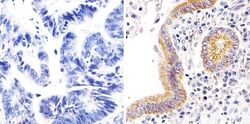
- Experimental details
- Immunohistochemistry analysis of Claudin-1 showing staining in the membrane of paraffin-embedded human colon carcinoma (right) compared to a negative control without primary antibody (left). To expose target proteins, antigen retrieval was performed using 10mM sodium citrate (pH 6.0), microwaved for 8-15 min. Following antigen retrieval, tissues were blocked in 3% H2O2-methanol for 15 min at room temperature, washed with ddH2O and PBS, and then probed with a Claudin-1 Rabbit Polyclonal Antibody (Product # 51-9000) diluted in 3% BSA-PBS at a dilution of 1:20 overnight at 4°C in a humidified chamber. Tissues were washed extensively in PBST and detection was performed using an HRP-conjugated secondary antibody followed by colorimetric detection using a DAB kit. Tissues were counterstained with hematoxylin and dehydrated with ethanol and xylene to prep for mounting.
- Submitted by
- Invitrogen Antibodies (provider)
- Main image
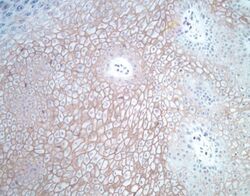
- Experimental details
- Immunohistochemical staining of human skin tissue using Rabbit anti-Claudin-1 Polyclonal Antibody (PAD: JAY.8). (Product # 51-9000).
- Submitted by
- Invitrogen Antibodies (provider)
- Main image
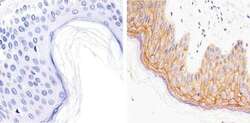
- Experimental details
- Immunohistochemistry analysis of Claudin-1 showing staining in the cytoplasm and membrane of paraffin-embedded human skin tissue (right) compared to a negative control without primary antibody (left). To expose target proteins, antigen retrieval was performed using 10mM sodium citrate (pH 6.0), microwaved for 8-15 min. Following antigen retrieval, tissues were blocked in 3% H2O2-methanol for 15 min at room temperature, washed with ddH2O and PBS, and then probed with a Claudin-1 Rabbit Polyclonal Antibody (Product # 51-9000) diluted in 3% BSA-PBS at a dilution of 1:100 overnight at 4°C in a humidified chamber. Tissues were washed extensively in PBST and detection was performed using an HRP-conjugated secondary antibody followed by colorimetric detection using a DAB kit. Tissues were counterstained with hematoxylin and dehydrated with ethanol and xylene to prep for mounting.
Supportive validation
- Submitted by
- Invitrogen Antibodies (provider)
- Main image
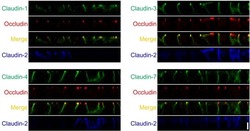
- Experimental details
- Fig 5 Localization of claudins in z-axis plane in control and claudin-2 knockout cells. Immunofluorescence analysis of claudins and occludin in co-culture of control MDCK II cells and claudin-2 knockout clone 1 (KO 1) in z-axis plane. The signals of claudin-1, -3, -4 and -7 were stronger at TJs in claudin-2 knockout cells compared with control cells, and lateral localization of these claudins was similar between control and claudin-2 knockout cells. Scale bar = 5 mum.
- Submitted by
- Invitrogen Antibodies (provider)
- Main image
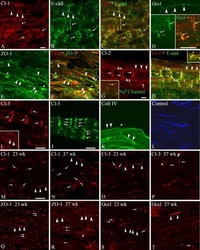
- Experimental details
- NULL
- Submitted by
- Invitrogen Antibodies (provider)
- Main image
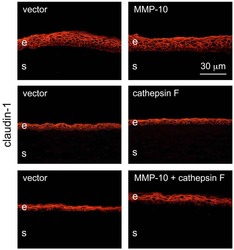
- Experimental details
- NULL
- Submitted by
- Invitrogen Antibodies (provider)
- Main image
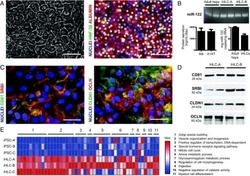
- Experimental details
- NULL
- Submitted by
- Invitrogen Antibodies (provider)
- Main image
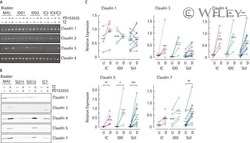
- Experimental details
- NULL
- Submitted by
- Invitrogen Antibodies (provider)
- Main image
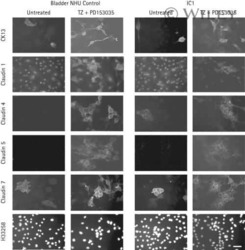
- Experimental details
- NULL
- Submitted by
- Invitrogen Antibodies (provider)
- Main image
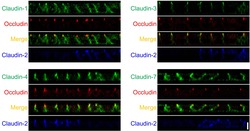
- Experimental details
- NULL
- Submitted by
- Invitrogen Antibodies (provider)
- Main image
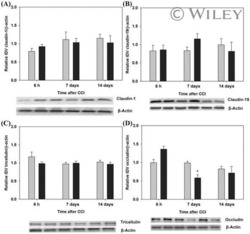
- Experimental details
- NULL
- Submitted by
- Invitrogen Antibodies (provider)
- Main image
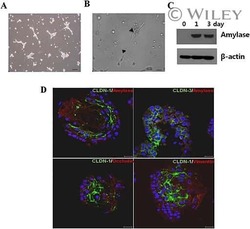
- Experimental details
- NULL
- Submitted by
- Invitrogen Antibodies (provider)
- Main image
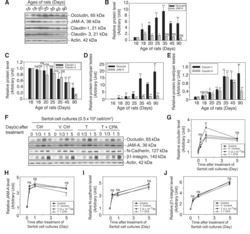
- Experimental details
- NULL
- Submitted by
- Invitrogen Antibodies (provider)
- Main image
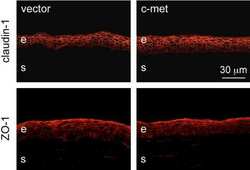
- Experimental details
- NULL
- Submitted by
- Invitrogen Antibodies (provider)
- Main image
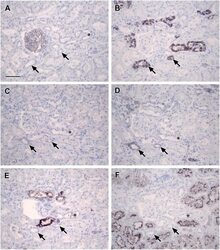
- Experimental details
- Fig. 9 Localization of claudin-1: photomicrographs showing serial sections of human renal cortical tissue stained for ZO-1 ( A ), calbindin ( B ), aquaporin-2 ( C ), claudin-1 ( D ), THP ( E ) and L. tetragonolobus ( F ) [claudin-1-, calbindin- and aquaporin-2-stained coincident tubules that were negative for THP and L. tetragonolobus (arrowheads in B-F); there were some calbindin positive tubules that were negative for claudin-1, THP and aquaporin-2 (asterisks in B-E); claudin-1 basolateral membrane location, corresponding with tubules showing discrete junctional ZO-1 staining (arrowheads in A and D); robust ZO-1 staining was seen in glomerular epithelial cells (A); scale bar 100 um].
- Submitted by
- Invitrogen Antibodies (provider)
- Main image
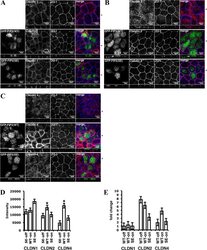
- Experimental details
- FIGURE 10: Overexpression of either GFP-Rab11-FIP2-WT or GFP-Rab11-FIP2 (S227E) altered the claudin content of tight junctions. GFP-Rab11-FIP2-WT-on and GFP-Rab11-FIP2(S227E)-on and -off were grown for 5 d postconfluence on Transwell filters. The cells were fixed then stained for claudin-1 (A), claudin-2 (B), or claudin-4 (C) and ZO-1. In the merged image, GFP-Rab11-FIP2s are pseudocolored green, the claudins are red, and ZO-1 is blue. (D) Cells were grown as described, then lysed, run on Western blots, and probed for the different claudins and VDAC. Three separate blots were scanned and quantified using ImageJ and normalized to control (VDAC). *p
- Submitted by
- Invitrogen Antibodies (provider)
- Main image
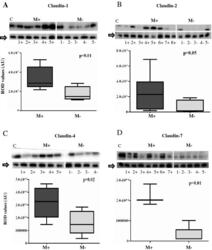
- Experimental details
- Figure 1 Comparison of expression levels of claudins- 1 (1A), 2 (1B), 4 (1C) and 7(1D) in Misoprostol treated (M+) (samples 1+ to 7+) versus untreated (M-) (samples 1- to 5-) cervix . Representative immunoblots in the top panels whilst box plots, lower panel, represent mean (SE) relative optical densities (ROD) for all studied tissues: M+ (n = 10) vs. M- (n = 5). Block arrows showing Gbetaeta as internal loading control at 35 kDa. C-positive control in the first lane. C-1 = claudin-1; C-2 = claudin-2; C-4 = claudin-4; C-7 = claudin-7. ROD- relative optical density in Arbitrary Units (AU).
- Submitted by
- Invitrogen Antibodies (provider)
- Main image
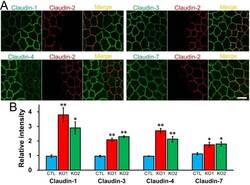
- Experimental details
- Fig 4 Effects of claudin-2 knockout on the localization of other claudins. (A) Immunofluorescence analysis of claudins in co-culture of control MDCK II cells and claudin-2 knockout clone 1 (KO 1). Claudin-1, -3, -4, and -7 showed clearer and stronger signals at TJs in claudin-2 knockout cells than in control cells. Scale bar = 10 mum. (B) Quantification analysis of signal intensity of claudins at TJs in control MDCK II cells and claudin-2 knockout clones. The signal intensity of claudins at TJs in control cells and claudin-2 knockout clones was measured as described in Materials and Methods , and the relative signal intensity of each claudin was calculated as the ratio of the signal intensity in control cells (CTL) and claudin-2 knockout clones (KO 1 and 2) to the signal intensity in control cells. N = 4 for each experiment. * p < 0.05, ** p < 0.01 compared with control.
- Submitted by
- Invitrogen Antibodies (provider)
- Main image

- Experimental details
- Fig 5 Localization of claudins in z-axis plane in control and claudin-2 knockout cells. Immunofluorescence analysis of claudins and occludin in co-culture of control MDCK II cells and claudin-2 knockout clone 1 (KO 1) in z-axis plane. The signals of claudin-1, -3, -4 and -7 were stronger at TJs in claudin-2 knockout cells compared with control cells, and lateral localization of these claudins was similar between control and claudin-2 knockout cells. Scale bar = 5 mum.
- Submitted by
- Invitrogen Antibodies (provider)
- Main image
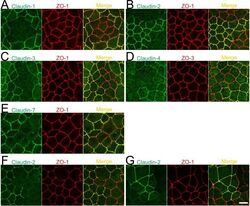
- Experimental details
- Fig 11 Localization of claudins at TJs between control and their respective knockout cells. (A-E) Immunofluorescence analysis of claudins and ZO-1 or ZO-3 in MDCK II cells transfected with the TALEN constructs for claudin-1, -2, -3, -4, or-7 gene knockouts. After transfection, cells were subcultured on filter inserts for 4 days before the analysis of claudin-2 and -3 (B and C), and for 2 days before the analysis of claudin-1, -4, and -7 (A, D, and E). (F) Immunofluorescence analysis of claudin-2 and ZO-1. TALEN constructs for the claudin-2 gene knockout were transfected into MDCK II cells, which were subcultured on filter inserts for 2 days before analysis. (G) Immunofluorescence analysis of claudin-2 and ZO-1 in a co-culture of wild-type and claudin-2 expressing MDCK I cells. Cells were cultured on filter inserts for 4 days before analysis. Scale bar = 10 mum.
- Submitted by
- Invitrogen Antibodies (provider)
- Main image
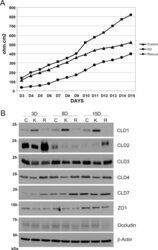
- Experimental details
- FIGURE 6: Rab25 depletion alters the transepithelial resistance and claudin expression. (A) TER was measured in all cell lines from day 3 to day 15 on Transwell filters. During this period, the media were changed every day, and TER was measured in 24-well Transwell inserts. Results are expressed in ohm-cm 2 and are representative of three separate experiments. (B) Equal amounts of total protein lysates (20 mug) from Control, Rab25KD, and Rescue cells were analyzed by Western blots for tight junction proteins. The blots were subsequently stripped and reprobed for beta-actin as a loading control. The results are representative of three separate experiments.
- Submitted by
- Invitrogen Antibodies (provider)
- Main image
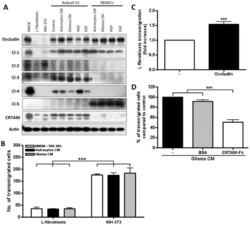
- Experimental details
- Figure 6 Expression of TJ proteins in transmigrating cells favors their passage across RBMECs. A) Analysis by Western blots of the expression of occludin, claudins 1 to 5 and CRTAM in NIH-3T3and L-fibroblasts, ReNcells CX and RBMECs. B) The transmigration of NIH-3T3 and L-fibroblasts acrossRBMECs is independent of the CM present in the basal compartment, but is significantly higher inNIH-3T3 fibroblasts that express claudin-2 than in L-fibroblast that do not express TJ proteins.N = 3, F(1,6) = 232.22, ***P
- Submitted by
- Invitrogen Antibodies (provider)
- Main image
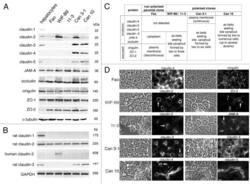
- Experimental details
- Figure 4. Expression and localization of tight junction (TJ) proteins in cell lines expressing typical hepatocyte polarity. Fully polarized cultures were examined. ( A ) western blot. Each lane was loaded with a cell lysate aliquot containing 25 mug total protein. ( B ) RT-PCR. For western blot and RT-PCR, experiments were performed three times with lysates or RNA preparations from two to three independent cultures; one representative experiment is shown. ( C ) Summary of the localization of ten TJ proteins. Experiments were performed at least three times on three independent cultures. ( D ) Images of the localization of some TJ proteins; for each case, the corresponding phase-contrast image is given on the left. Some bile canaliculi (BC) are indicated by arrows (short arrows for BC formed between two cells, long arrows for extended BC). Bar, 10 mum
- Submitted by
- Invitrogen Antibodies (provider)
- Main image
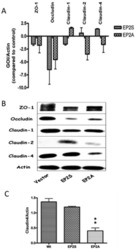
- Experimental details
- Figure 3 The expression of tight junction mRNA and proteins in Caco-2 EP2 receptor transfectants. (A) The mRNA expression for tight junction proteins (ZO-1, occludin, claudin-1, claudin-2 and claudin-4) in Caco-2 EP2S and EP2A cells was measured by Q-PCR. The expression of gene of interest (GOI) was normalized with the internal control (Actin) and expressed as fold changes with that of the vector control. (B) A representative immunoblot showing constitutive expression of the important tight junction proteins (ZO-1, occludin, claudin-1, claudin-2 and claudin-4) in EP2S, EP2A and vector control cells. Actin used as internal control. (C) Densitometry analysis for claudin-4 expression in EP2S, EP2A and vector control cells. EP2A compared statistically with the vector control. p
- Submitted by
- Invitrogen Antibodies (provider)
- Main image
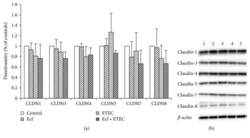
- Experimental details
- Figure 3 Protein expression (Western blot) of claudin-1, claudin-3, claudin-4, claudin-5, claudin-7, and claudin-8 after treatment with bacterial strains (Ecf, ETEC, and Ecf + ETEC). (a) Protein expression relative to respective controls [means +- SEM]. Samples were taken after 8 h. No differences were observed between treatment groups. N = 3 independent experiments per bar. (b) Exemplarily, data of one Western blot is shown. 1 = control (8 h), 2 = Ecf (8 h), 3 = ETEC (8 h), 4 = Ecf (8 h) + ETEC (6 h), and 5 = Ecf (10 h) + ETEC (8 h). Sample 4 was included as a control to rule out effects of longer total bacterial incubation (preincubation) and was not included in the statistical analysis shown in (a).
- Submitted by
- Invitrogen Antibodies (provider)
- Main image
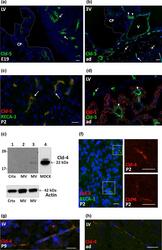
- Experimental details
- Fig. 6 Claudin-5 and claudin-4 are expressed in endothelial cells in the developing brain a - d . Cld-5 immunoreactivity in the developing and adult brain. Parenchymal vessels are labeled ( green ) in E19 ( arrows a ) or adult ( arrows b , d ) animals. In c , the anti-Cld-5 polyclonal antibody was used to show the colocalization of the TJ protein ( red ) with the endothelial marker RECA-1 ( green ) in a P2 animal. In all CPs immunodetection revealed a signal associated with the largest vessels penetrating the choroidal stroma ( arrowheads b , d ), but not with the choroidal epithelium, labeled in red by anti-Cld-1 Ab ( d ). Note that all cisternal vessels such as the vein of Galen are also labeled by anti-Cld-5 Ab. DAPI was used for nuclei staining. e Representative Western blot of Cld-4. Brain cortex ( lane 1 20 mug) and MV ( lanes 2 and 3 40 mug) were isolated from adult animals. Lane 4 was loaded with MDCK (10 mug) as positive control. A low, but specific Cld-4 signal was detected in MV ( upper panel lane 3 band at 22 kDa), but not in cortex or in MV when the primary antibody was omitted ( lane 2 ). Actin used as a loading indicator is shown in the lower panel (42 kDa band). Due to the high expression of Cld-4 in MDCK cells, lane 4 was treated separately from the other lanes for HRP detection. f - h Cld-4 immunoreactivity ( red ) in the developing and adult brain. Double immunolabeling with anti-RECA-1Ab ( green ) allowed visualizing the parenchymal vessels that were posit
- Submitted by
- Invitrogen Antibodies (provider)
- Main image
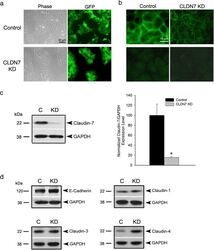
- Experimental details
- Fig. 1 Knockdown of claudin-7 in HCC827 lung cancer cells. a Representative phase and green fluorescence images of live control and claudin-7 KD cells. Both control and claudin-7 shRNA lentivirus constructs contain a GFP expression sequence. b Top panel is the anti-claudin-7 immunofluorescence staining of control and claudin-7 KD cells. Claudin-7 level was dramatically decreased in claudin-7 KD cells. The bottom panel is the anti-GFP immunofluorescence staining. The cells were fixed with 100 % methanol, which lead to GFP proteins leaking out of the cells so that the green fluorescence shown in the top panel was only the claudin-7 signal. c Western blot shows the diminished level of claudin-7 in the KD cells ( left ). The statistical analysis of claudin-7 expression in control and KD cells from five independent experiments is shown on right. * P < 0.05. d Protein expression levels of E-cadherin, claudin-1, -3, and -4 in control and KD cells. Only claudin-4 expression level was increased in KD cells. GAPDH served as a loading control
- Submitted by
- Invitrogen Antibodies (provider)
- Main image
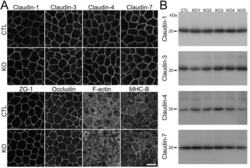
- Experimental details
- Fig 3 Effects of claudin-2 knockout on the localization of other TJ proteins and cytoskeleton. (A) Immunofluorescence analysis of claudin-1, -3, -4, -7, ZO-1, occludin, F-actin, and myosin heavy chain II-B (MHC-B) in control and claudin-2 knockout cells. Claudin-1 and -7 showed a tendency to be more clearly localized at TJs in claudin-2 knockout cells. Scale bar = 10 mum. (B) Immunoblots of claudin-1, -3, -4, and -7 in control MDCK II cells and claudin-2 knockout clones. Similar expression levels of claudin-1, -3, -4, and -7 were observed in control cells and knockout clones.
- Submitted by
- Invitrogen Antibodies (provider)
- Main image
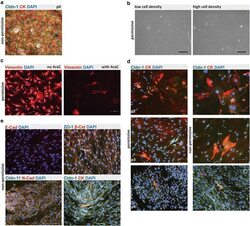
- Experimental details
- Fig. 2 Phenotype and irreversible de-differentiation of Immortomouse (r) CPECs. a Primary Immortomouse (r) choroid plexus epithelial cells (p0) grown at 37 degC for 7 days showed the same staining patterns for cytokeratin (CK) and claudin-1 (Cldn-1) as pmCPECs isolated from wild-type mice. b When Immortomouse (r) CPECs were grown under permissive conditions (33 degC, 10U IFNgamma) the heterogenous de-differentiation process started in areas with low cell density, whereas CPECs kept their cuboidal shape longer in areas with high cell density. The contrast of the pictures in a and b was enhanced using Adobe Photoshop software. c Vimentin staining, rather than CK staining was observed at 33 degC. Cell death took place at 33 degC upon Ara-C addition to culture. d The irreversible loss of CPEC specific markers Cldn-1 and CK and an increasing proliferation rate of de-differentiated Immortomouse (r) CPECs was observed with increased passage. The first row is passage 2 (p2), the second row is p3, the third row is p4. e The cells failed to form confluent monolayers or display the correct expression pattern of epithelial markers upon shift to non-permissive temperature and IFNgamma withdrawal. Immortomouse (r) CPECs in e were stained after 7 days of non-permissive growth; the passage numbers (p) were E-cad/DAPI: p8, ZO1/beta-Cat/DAPI: p5, Cldn11/N-Cad/DAPI: p6, Cldn-1/CK/DAPI: p4. Scale bar in all immunofluorescent and phase contrast pictures = 100 mum. p0 primary culture, E-Cad E-cadh
- Submitted by
- Invitrogen Antibodies (provider)
- Main image

- Experimental details
- Fig. 4 Phenotype of ECPC4 cells and primary mouse choroid plexus epithelial cells (pmCPECs). Immunofluorescence staining for CPEC specific proteins is shown in ECPC4 cells ( a ) and pmCPECs ( b ). a There is weak staining for the adhesion junction (AJ) protein E-Cadherin (E-Cad) and its cytoskeleton linker beta-catenin (beta-Cat) of ECPC4 cells and their localization is not specifically at the plasma membrane. Staining for tight junctional (TJ) claudins-1 and -11 was absent or showed a weak cytosolic pattern, respectively. The scaffolding protein ZO1 staining was disrupted. Additionally, the cell line failed to stain for the early epithelial marker cytokeratin but rather was positive for the mesenchymal intermediate filament protein vimentin. ECPC4 cells from passage 41 were stained on d4 in culture. b In contrast, the staining of pmCPECs stained on d7 in culture, revealed a proper distribution of all epithelial markers. pmCPECs. All staining was performed at least 3 times. Scale bars 50 mum. E-Cad E-cadherin, Cldn-1 Claudin 1, Cldn-11 claudin 11, CK cytokeratin, beta-Cat beta-catenin, ZO-1 zona occludens protein 1
- Submitted by
- Invitrogen Antibodies (provider)
- Main image
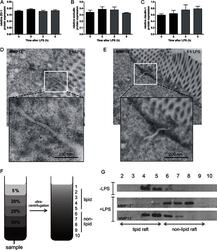
- Experimental details
- Figure 3 MMP13 contributes to tight junction destabilization Source data is available for this figure in the Supporting Information. A-C. Western blot quantification of the protein expression levels of ZO-1 (A), occludin (B) and claudin (C) in mucosal scrapings of ilea from MMP13 +/+ (black) and MMP13 -/- (grey) mice 0 and 8 h after LPS injection ( n = 3-4). D,E. Representative ZO-1 immunogold-labeled TEM images of MMP13 +/+ (D) and MMP13 -/- (E) mice 8 h after LPS injection. F. Schematic overview of the separation of the lipid raft and non-lipid-raft fractions by ultracentrifugation. G. Caveolin-1 western blot analysis of fractions obtained after ultracentrifugation of mucosal scrapings from MMP13 +/+ and MMP13 -/- mice 0 and 8 h after LPS challenge.
- Submitted by
- Invitrogen Antibodies (provider)
- Main image
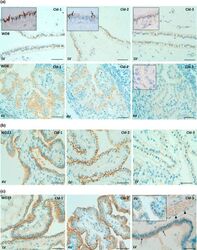
- Experimental details
- Fig. 8 Immunohistochemical detection of claudins in choroid plexuses of developing human brain. Immunoreactivity of Cld-1, -2, and -3 is presented on the left, central, and right panels , respectively, with hematoxylin counterstaining. a Staining of a WD8 fetal brain. Cld-1 labeling, observed in both LVCP and 4VCP, was continuous and localized apically at intercellular junctions of the epithelium ( arrows in inserted high magnification micrograph ). Cld-2 immunoreactivity displayed a similar apical, but patchy pattern in both LVCP and 4VCP. The higher magnification ( insert in LVCP) illustrates the discontinuous labeling ( arrows ). Cld-3 was also detected in the epithelium of both CP ( arrows ). Inserts are higher magnifications highlighting the continuous staining pattern. b Staining of a WD22 fetal brain. Cld-1 immunoreactivity was present at all epithelial junctions (shown in 4VCP). A continuous apical labeling of the epithelium was observed for Cld-2 (LVCP is shown). Cld-3 labeling was faint but continuous in LVCP epithelial cells. c Staining of a WD39 fetal brain. A distinct and continuous labeling of the choroidal epithelium was observed for all Cld-1 (shown for LVCP), -2 (shown for 4VCP), and -3. The continuous signal for Cld-3 was only associated with the epithelium ( arrows ) and not with stromal vessels ( arrowheads in LVCP). The insert shows a similar Cld-3 staining for 4VCP. Abbreviations as in Fig. 2 . Scale bar 50 mum
- Submitted by
- Invitrogen Antibodies (provider)
- Main image
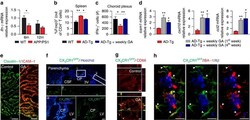
- Experimental details
- Figure 3 Immunomodulation that reduces systemic Treg levels activates the CP for mo-MPhi trafficking and mitigates AD pathology. ( a ) mRNA expression levels of ifn-gamma , measured by RT-qPCR, in CPs isolated from 6- and 12-month-old APP/PS1 AD-Tg mice, compared with age-matched WT controls ( n =5-8 per group; Student's t -test). ( b , c ) 5XFAD AD-Tg mice were treated with either weekly GA or vehicle (PBS), and were examined at the end of the 1st week of the administration regimen (after a total of two GA injections). Flow cytometry analysis of CD4 + Foxp3 + splenocyte frequencies ( b ) and CP-resident IFN-gamma-expressing immune cells (intracellularly stained and pre-gated on CD45) ( c ), in treated 6-month-old AD-Tg mice, compared with age-matched WT controls ( n =4-6 per group; one-way ANOVA followed by Newman-Keuls post hoc analysis). ( d ) mRNA expression levels for the genes icam1 , cxcl10 and ccl2 , measured by RT-qPCR, in CPs of 4-month-old AD-Tg mice, treated with either weekly GA or vehicle, and examined either at the end of the 1st or 4th week of the weekly GA regimen ( n =6-8 per group; one-way ANOVA followed by Newman-Keuls post hoc analysis). ( e ) Representative microscopic images of 6-month-old AD-Tg mice following weekly GA, stained for ICAM-1 (in red) and Claudin-1 (in green; epithelial tight junctions), showing elevated levels of ICAM-1 immunoreactivity, as compared with vehicle-treated AD-Tg (scale bar, 50 mum). ( f ) Representative images of brain
 Explore
Explore Validate
Validate Learn
Learn Western blot
Western blot ELISA
ELISA Immunohistochemistry
Immunohistochemistry